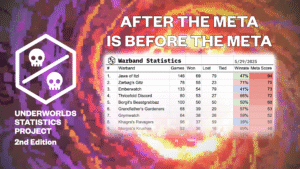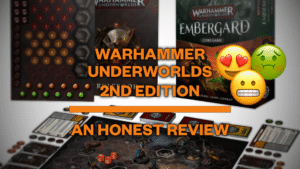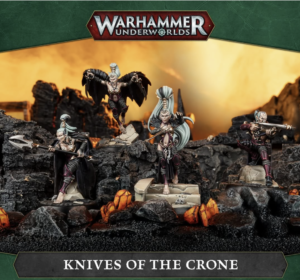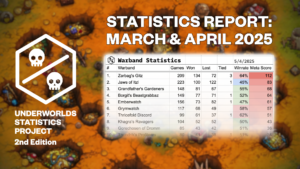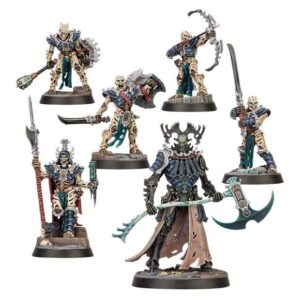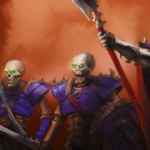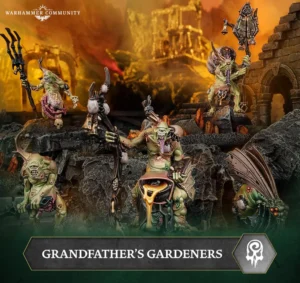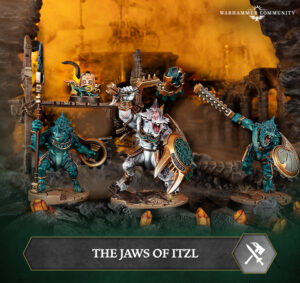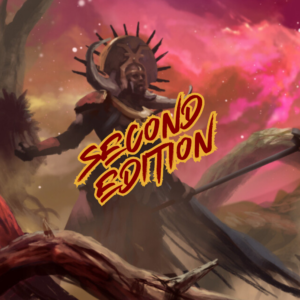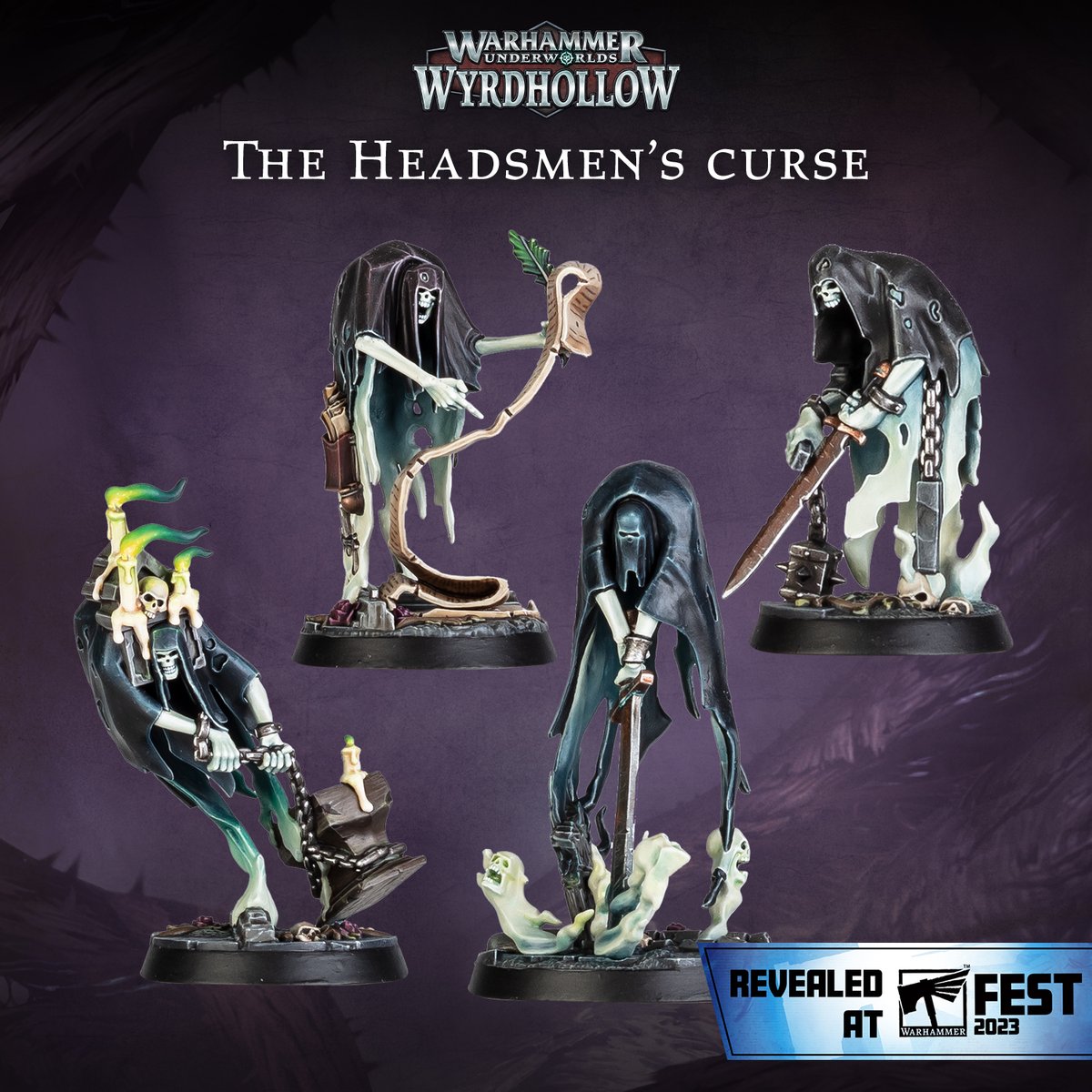
Intro
Today is a special day because it marks the first time (thanks to Path to Glory, and of course GW) that I have been able to release a review article for a new release on the day the pre-order actually goes live. I have to say, I much prefer doing it this way! In today’s article, we are covering the new Headsmen’s Curse warband. While I do tend to prefer skeletons aesthetically, I think these guys look pretty good, especially considering it is a 4-fighter ghost warband where it is immediately obvious which one is which. Not only are the models nice and distinct, but they have very helpfully named them about as literally as you possibly could. “Hey, which one’s that guy carrying that big block?” “That would be the Bearer of the Block…” I actually find this extremely charming and I think using items like this to distinguish similar models is very helpful for players to get familiar with the warbands. Heck, I am familiar with every warband and I still forget which one is Grodrig or Haqfel, or similarly The Screaming Maiden or The Anguished One, when they’re actually on the table in front of me. In any case, we’ve got a whole warband’s worth of cards to wade through, so let’s get started!
Plot Card

The developers definitely seem to be in a cycle of using plot cards to increase their design space and we’ve got another one here for the Headsmen’s Curse. This plot card is all about how your warband acquires “Condemned” counters (without using fighter or power card abilities/effects), where you (the player) need to collect 3 such counters to inspire your whole warband at the end of a power step. Per the Awaiting Execution rule, when you add these counters to enemy fighters, they can only ever be holding a maximum of 1 counter. You may collect these counters through Justice is Served, where you gain a “Condemned” counter each time you take out an enemy fighter that had one. Similarly, you may also collect additional counters through the Well-Executed rule, which allows you to gain additional counters for taking out an adjacent target with an attack action if the attack was supported or the target was Large. As written, you actually get two counters if both of these conditions are met, which you could pair with a third from Justice is Served to fully inspire off a single kill. This is all well and good and works just fine, but, if you’ve read my other articles, you’ll know that I’m not a huge fan of counter-based inspirations. I think if you go this route with a warband, you need some kind of competing use for the counters other than just having a certain number of them to score objectives. Specifically, finding interesting interactions with them in the power deck is critical, in my opinion. Kainan’s Reapers probably have the most directly comparable inspiration condition (and I wouldn’t be surprised if the bone tithe rules were on a plot card if Reapers were a modern-day release), but I think the design was executed far better in that instance. Funny how Reapers even manage to make their way into articles that are not about them… Sure, there are some objectives that care about counting up how many you have acquired, but there are also built-in uses for the counters that can factor into decision-making throughout a game. I’m cheating ahead a bit, but the Rivals deck for Headsmen’s Curse seems to miss out on counter interactions like we see in Reapers with [![]() Methodical Assault]
Methodical Assault]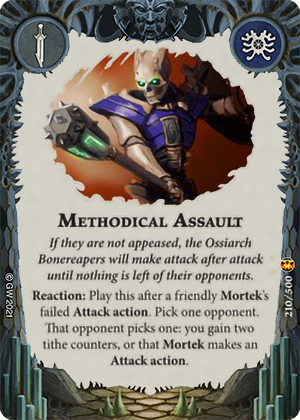 , [
, [![]() Exceptional Efficiency]
Exceptional Efficiency]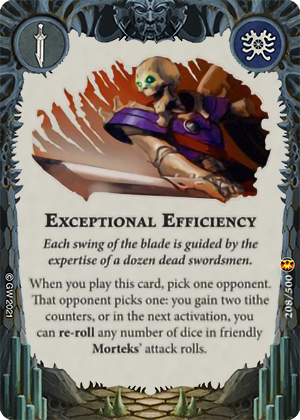 , [
, [![]() Lethal Accuracy]
Lethal Accuracy]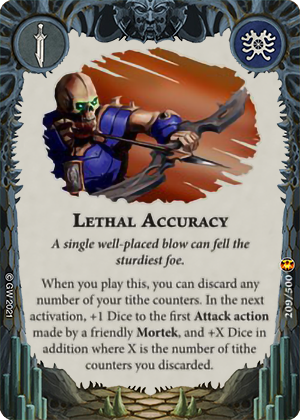 , [
, [![]() Tithestone]
Tithestone]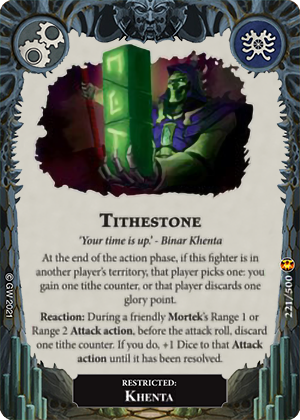 (and others not listed here), or even Kainan’s consumption of tithe counters for +Dice, +Move, or +Damage. Instead, condemned counters are similar to how exploration count worked with Daring Delvers, where you’re just counting a number until you inspire and maybe you also need that number to be a certain value for some objectives to score. I personally find this not very interesting and would prefer if there were some opportunity cost decisions to be made along the way, as I mentioned with Reapers. The condemned counter rules are fine, the wording is fine, it all works in the context of the warband and their deck, I just think it’s a bit of a missed opportunity in regard to the design of the warband.
(and others not listed here), or even Kainan’s consumption of tithe counters for +Dice, +Move, or +Damage. Instead, condemned counters are similar to how exploration count worked with Daring Delvers, where you’re just counting a number until you inspire and maybe you also need that number to be a certain value for some objectives to score. I personally find this not very interesting and would prefer if there were some opportunity cost decisions to be made along the way, as I mentioned with Reapers. The condemned counter rules are fine, the wording is fine, it all works in the context of the warband and their deck, I just think it’s a bit of a missed opportunity in regard to the design of the warband.
Fighters

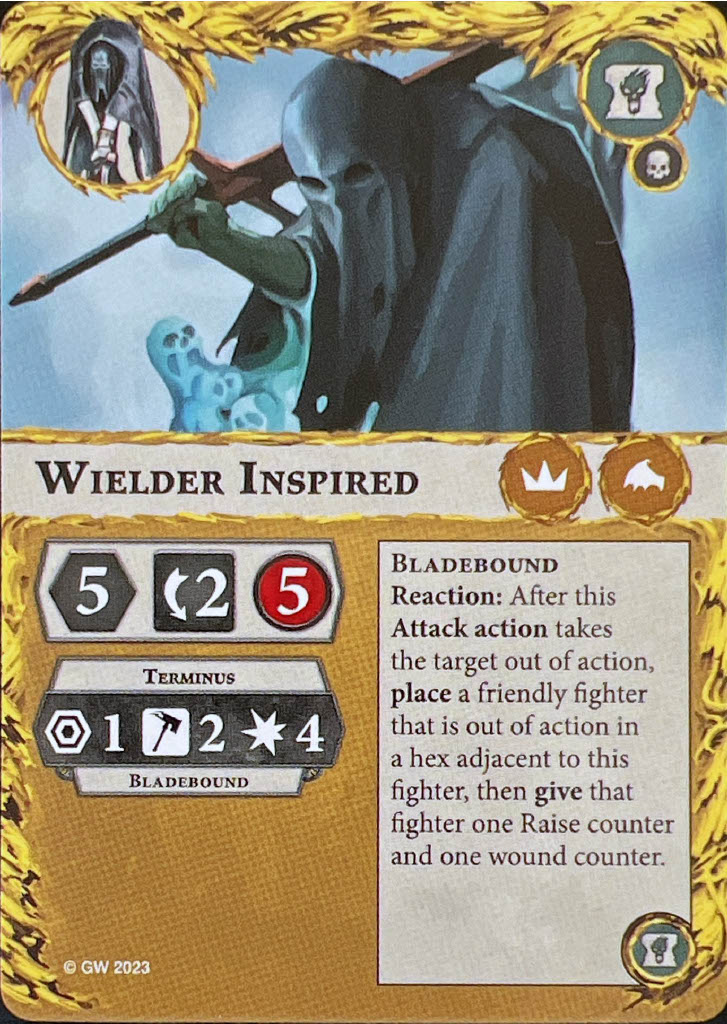
The leader of the warband (and by far the most important fighter) is Wielder of the Blade. You guessed it, he’s the one wielding the blade. A pretty bonkers base physical profile of 4 Move, 2 Dodge, 5 Wounds coupled with the flying keyword (which the entire warband has), but given that this is about as close to being a “big boy” warband as you can get without fully qualifying, I think his stats are appropriate for how much of the load he has to carry. Like many similarly dangerous fighters, he sports a 1R/2H/3D attack profile, but with the Bladebound ability, which allows you to resurrect your out-of-action friendly fighters and place them adjacent to you after you make a kill with this attack. That fighter also gets one wound counter. I like the idea that he is essentially replacing his servants with new ones as he takes more heads, and given that these (mostly) aren’t just some 2-Wound mopes he’s bringing back, I think it’s fair to build in the cost of coming back wounded. Upon collecting that third condemned counter for the inspire, the Wielder becomes an absolute heat-seeking missile, going up to 5 Move while also jumping to 4 Damage on his attack profile. As far as I can recall, this is the first time we’ve seen a fighter that (unupgraded and without using other abilities) can put out 4 Damage on a 6-hex threat range in a single activation. While terrifying, this again makes some sense in terms of how much work this particular fighter will have to do in order for you to win games. While some fighters will be able to tank this in Nemesis and Rivals (though many will still just die), this likely means that every fighter is in danger of dropping in 1 hit in Championship. That’s not necessarily a bad thing, but it does mean you can have those instances, like you do with Mollog, where you just crit+hit stuff and that’s how the game goes. Effective management of how many times you can get the Wielder to swing will be key in succeeding with this warband, while opponents will be looking to limit you to as few as possible.

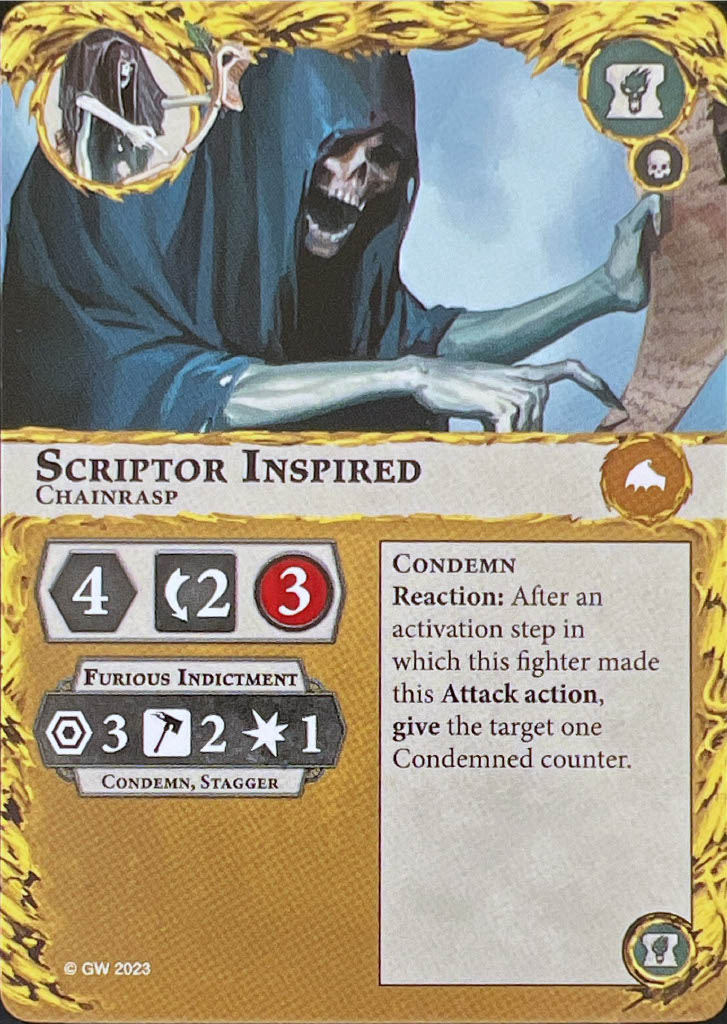
Next up is the Scriptor of the Sentence, a dreadfully wicked Chainrasp Santa Claus who has decided that your opponent’s whole warband is on the naughty list. He sports a much squishier profile of 4 Move, 1 Dodge, 3 Wounds and only has a 3R/2H/1D attack action with the Condemn keyword, which unsurprisingly gives a condemned counter to the target. Interestingly enough, if I am reading this correctly, you get to give the target this counter regardless of whether the attack action actually lands. Since he’s effectively just pointing and doing his best Nic Cage giving the Ghost Rider Penance Stare, I’d say this makes a lot of sense. When inspired, Scriptor goes to 2 Dodge and gains stagger on the attack action, further driving home the point that this fighter should be priming kills rather than attempting to claim them. I like when the natural abilities of a fighter tell you what to do with them, it’s particularly good design for newer players to better understand play sequencing. Overall, a perfectly fine fighter here, but the 3 minor players are obviously designed around supporting the Wielder.
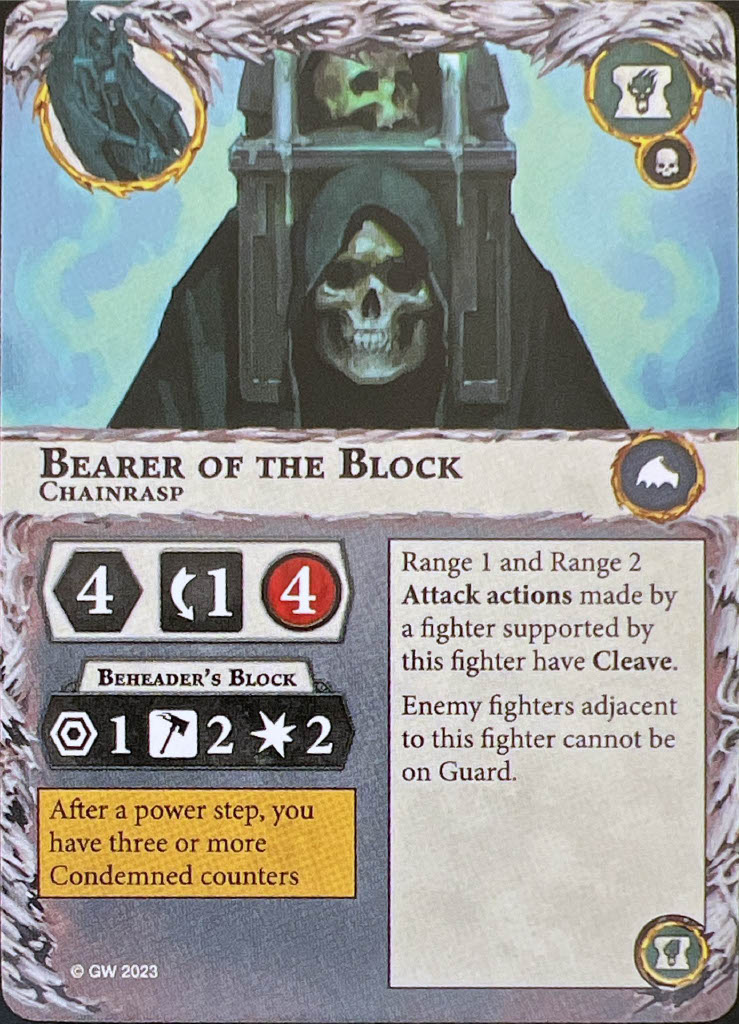
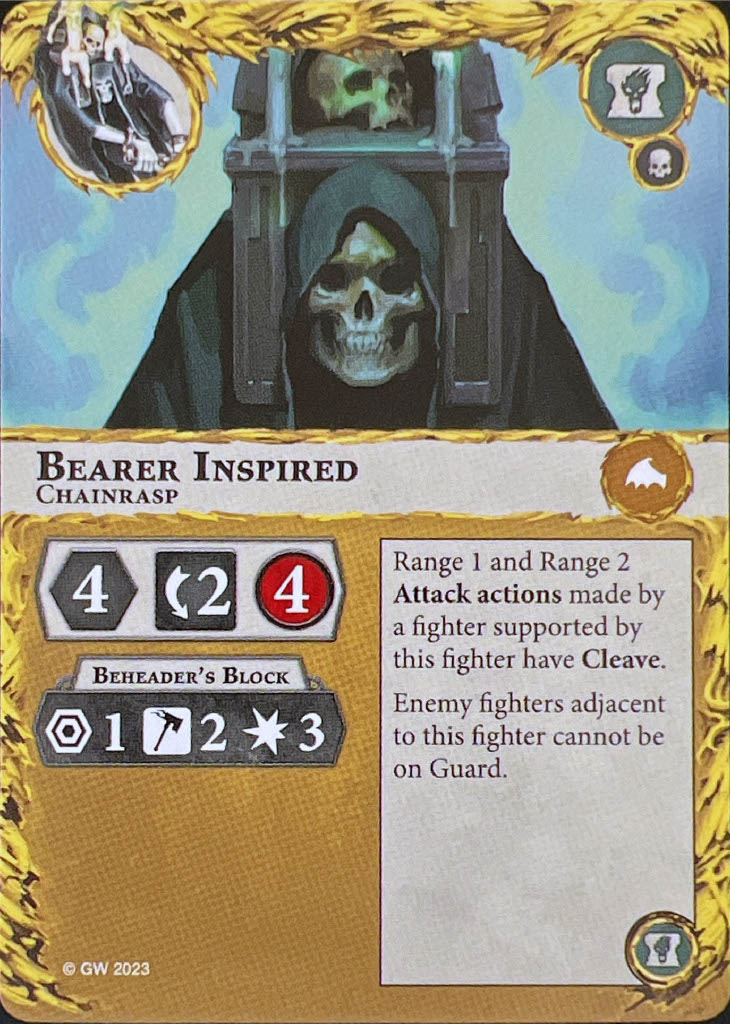
Our third fighter is the Bearer of the Block and is quite literally carrying around a chopping block for the Wielder to make use of. He’s a bit tankier than our previous Chainrasp, sporting a physical profile of 4 Move, 1 Dodge, 4 Wounds. As a blunt weapon, the chopping block is apparently pretty decent at a standard 1R/2H/2D profile. However, this fighter’s main purpose once again seems to be supporting kills, as it grants your attack actions cleave when supporting while also preventing adjacent enemy fighters from being on guard. Given that your leader maxes out at 2H for accuracy (on the fighter card), positioning of this fighter will be very key for making sure you’re able to take out your condemned targets. I also like the added flexibility of using his ability to help you drive back an on-guard fighter even if you won’t be able to kill them. Upon inspiring you go to 2 Dodge, which is obviously great for survivability, but you actually also jump to 3 Damage, making this fighter a threat in their own regard. Probably my favorite fighter in the warband just because I enjoy positioning-heavy pieces like this.
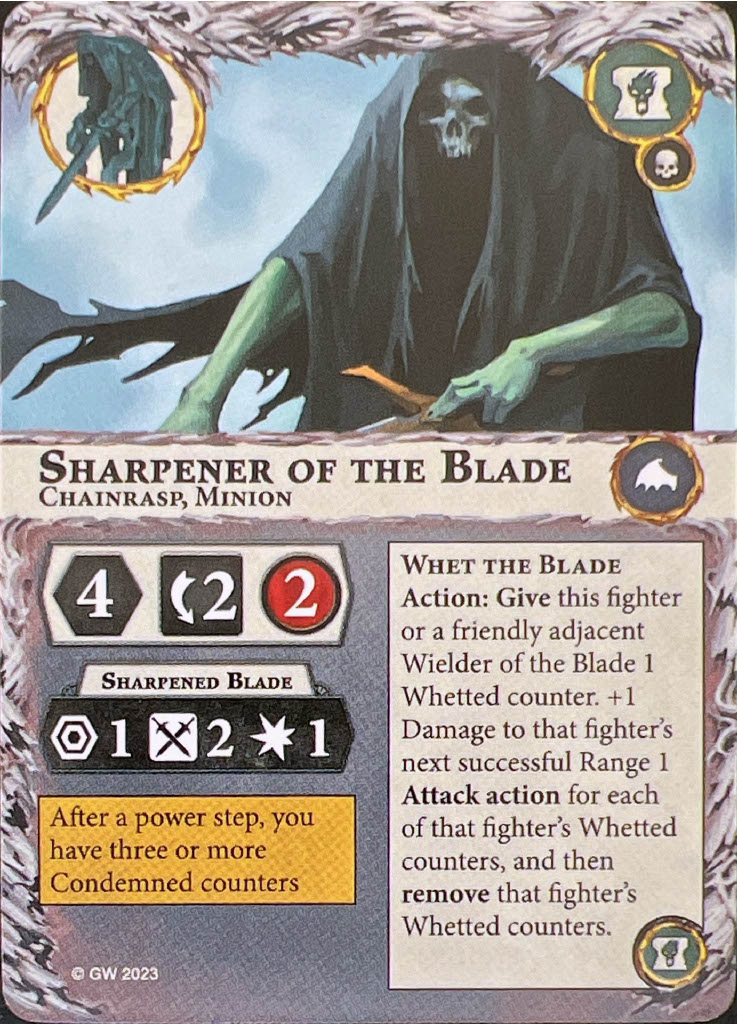
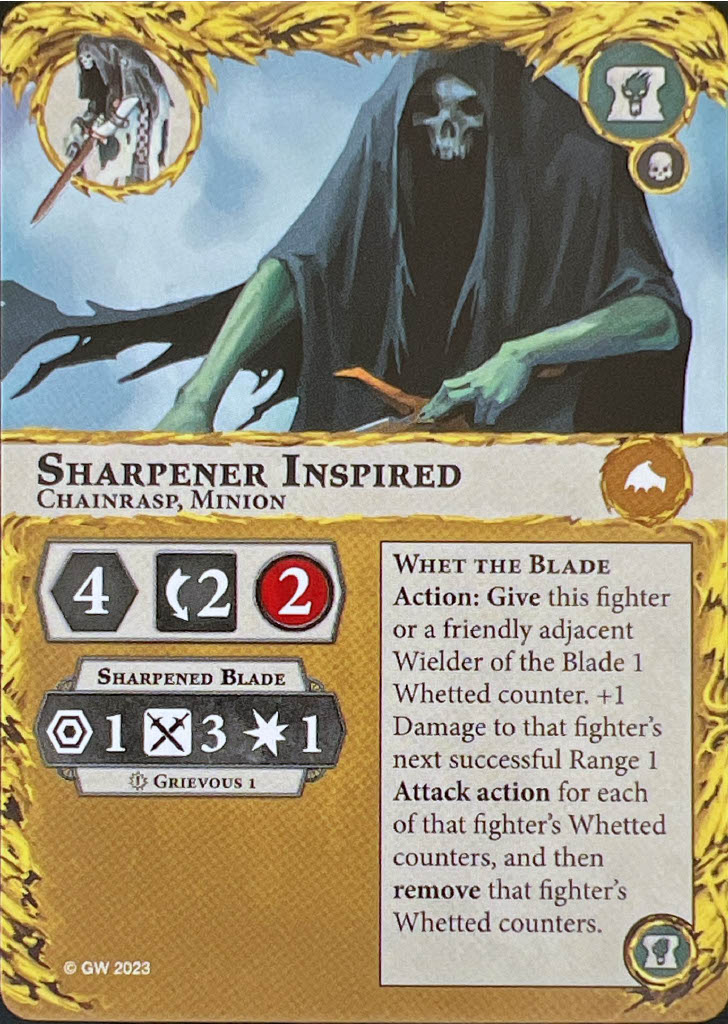
Our final fighter is the only Chainrasp in the warband to actually get the minion keyword as well, with the Sharpener of the Blade. The frailest of the bunch, he starts at 4 Move, 2 Dodge, 2 Wounds and a sad little attack of 1R/2S/1D. However, as is the case with the other Chainrasps, the goal here is to support the Wielder, as you can spend actions sharpening the Wielder’s weapon (if adjacent) to go and decapitate your opponent’s fighters. While this is neat thematically, having to spend an entire action just to give +1 Damage to an attack (granted, the counters persist until the attack lands) is hard to see as a primary goal. It really means you’re going all-or-nothing on Wielder actually landing the attack on that big target. That being said, I suppose it’s not like your other fighters are really doing all that much damage themselves. If you’re scared of a Kainan or Hrothgorn, maybe you can just sit back for 3 activations sharpening the blade, drop an accuracy gambit or two, and then use the Wielder to fell the big guy in one stroke, possibly even inspiring in the process. It’s never bad to have options, this just seems like an option you might only exercise once a game, if that. When inspired, Sharpener becomes moderately useful offensively, gaining grievous and an extra die on the attack, but still not much to write home about in the stats department.
As a unit, it is pretty clear the warband is built around the idea that the Chainrasps are there to support the Wielder as he executes one fighter after another. While being Range 1 does open him up for more accuracy options, I do worry that the lack of reach and overall dependence on the leader can make the warband susceptible to some negative play sequences where opponents can heavily control your most potent fighter. Cards like [![]() Ill-prepared]
Ill-prepared]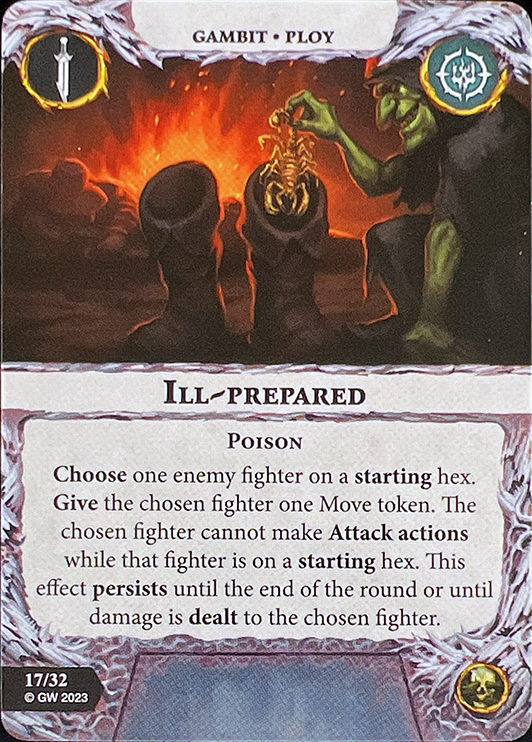 or [
or [![]() Freezing Venom]
Freezing Venom]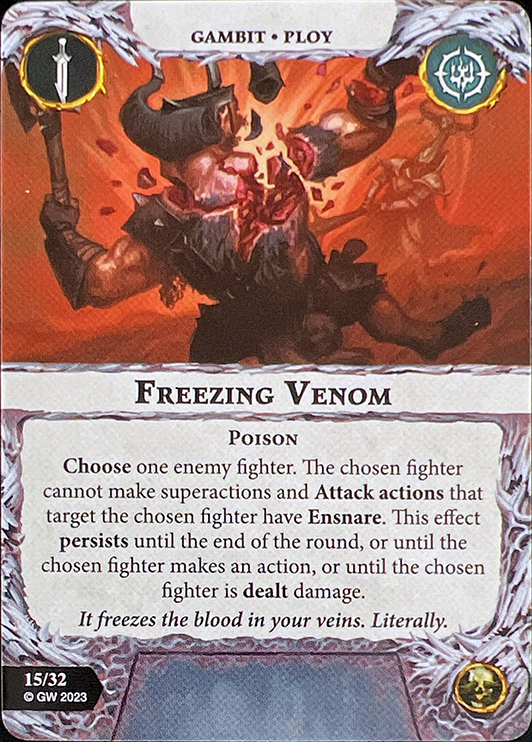 will be particularly debilitating for this warband and hot or cold dice sequences can make for a really bad day for either of the two players in the match. That being said, I do think, if you are comparing to Mollog or Hrothgorn, they have done a good job incentivizing you to make use of your other fighters and making each of the support pieces fill a particular role.
will be particularly debilitating for this warband and hot or cold dice sequences can make for a really bad day for either of the two players in the match. That being said, I do think, if you are comparing to Mollog or Hrothgorn, they have done a good job incentivizing you to make use of your other fighters and making each of the support pieces fill a particular role.
Objectives
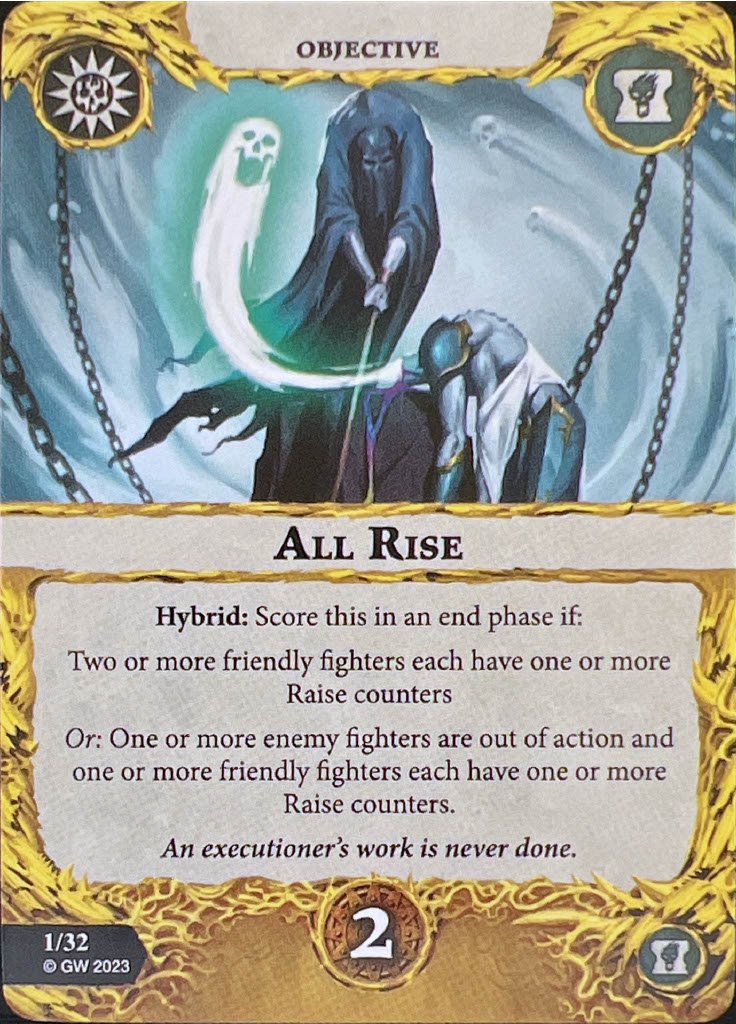
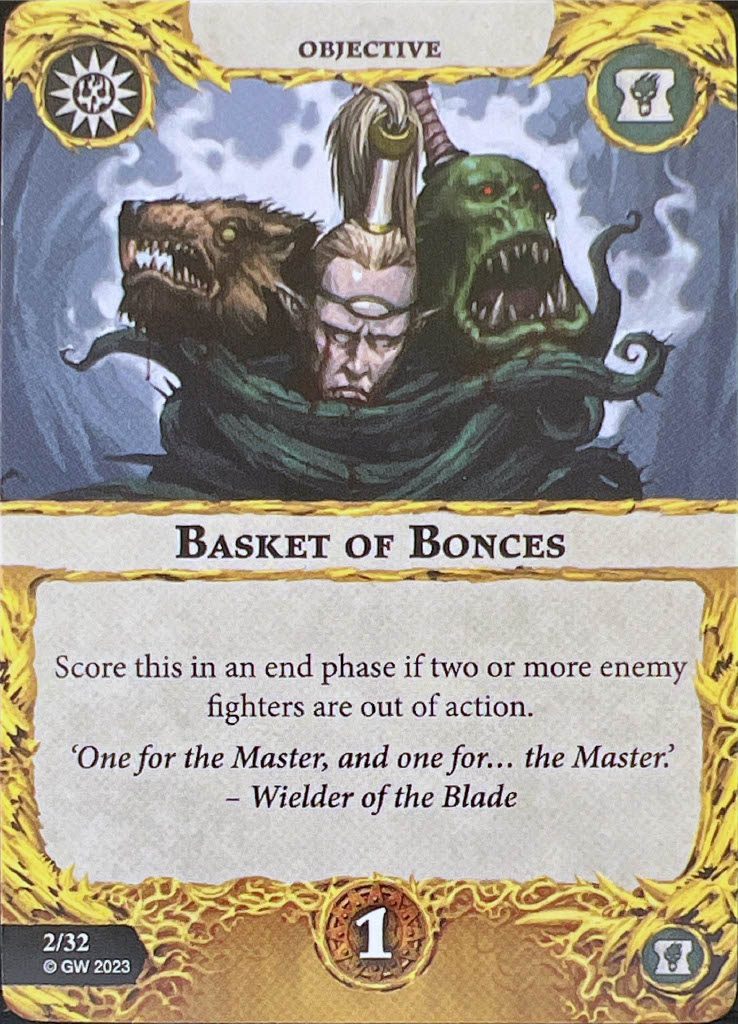
Starting off the objectives strong, we have All Rise, a 2-glory end phase for either having two or more friendly fighters with raise counters or one or more enemy fighters being out of action while one or more friendly fighters has a raise counter. I like that they’ve hybridized it, as it opens up the scoring window quite a bit. If it were just the first condition, accomplishing this in the first round would be quite difficult, but the hybrid condition basically makes it [![]() An Eye for an Eye]
An Eye for an Eye]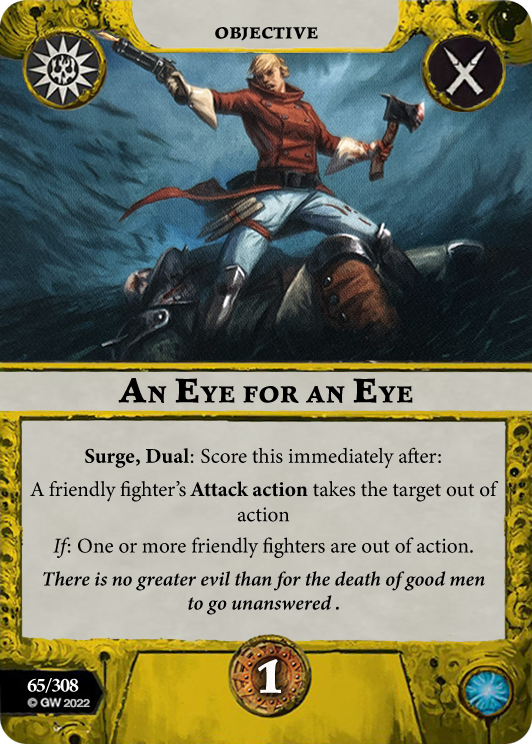 as an end phase card (assuming your leader is the one that makes the kill and your resurrected fighter is still standing). For 2 glory, I think the payoff is worth it here, and you can even potentially make this work with things going bad for you, as combining their in-faction resurrection tech with [
as an end phase card (assuming your leader is the one that makes the kill and your resurrected fighter is still standing). For 2 glory, I think the payoff is worth it here, and you can even potentially make this work with things going bad for you, as combining their in-faction resurrection tech with [![]() Partial Resurrection]
Partial Resurrection]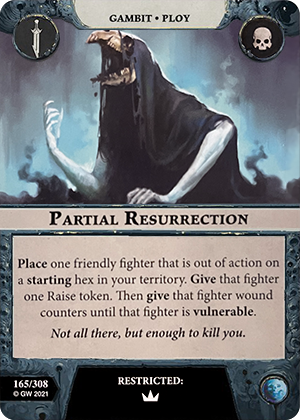 can make the resurrections a bit more dependable. I do think the current state of ping is such that resurrections are a bit of a dangerous game (feeding more glory), so that does push down the power ceiling a bit.
can make the resurrections a bit more dependable. I do think the current state of ping is such that resurrections are a bit of a dangerous game (feeding more glory), so that does push down the power ceiling a bit.
Power Ceiling: 2, Consistency: 2
The first of many cards with art focused on decapitation, Basket of Bonces is a 1-glory end phase for 2 or more enemy fighters being out of action. This is very much the going rate for this type of objective and it’s fine, but I think you are likely to want to swap this out even in Nemesis, especially since elite warbands tend to dominate the Nemesis meta in the first place, so killing 2 of those will almost never happen in the first round. What I find more hilarious is that [![]() Glorious Change]
Glorious Change]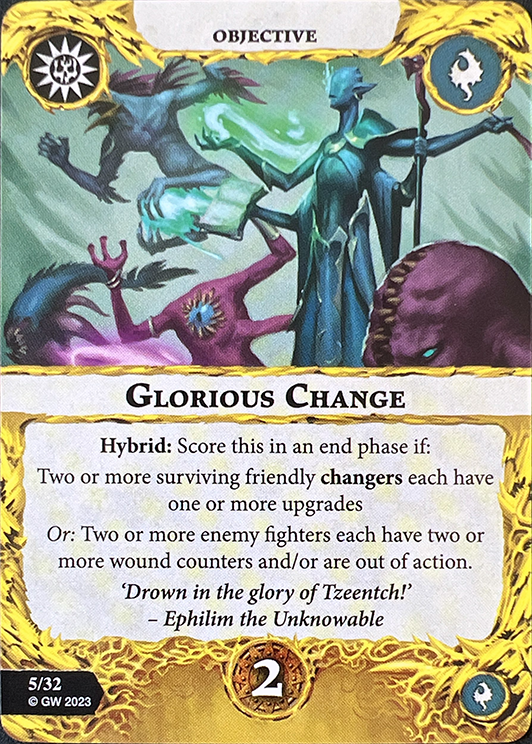 was printed in a warband of the same season and is significantly easier than this for a 2-glory payoff. Staying on topic though, this one is pretty straightforward. Nothing horrendously difficult, but there are much better options in the universal 1-glory end phase pool.
was printed in a warband of the same season and is significantly easier than this for a 2-glory payoff. Staying on topic though, this one is pretty straightforward. Nothing horrendously difficult, but there are much better options in the universal 1-glory end phase pool.
Power Ceiling: 1, Consistency: 2
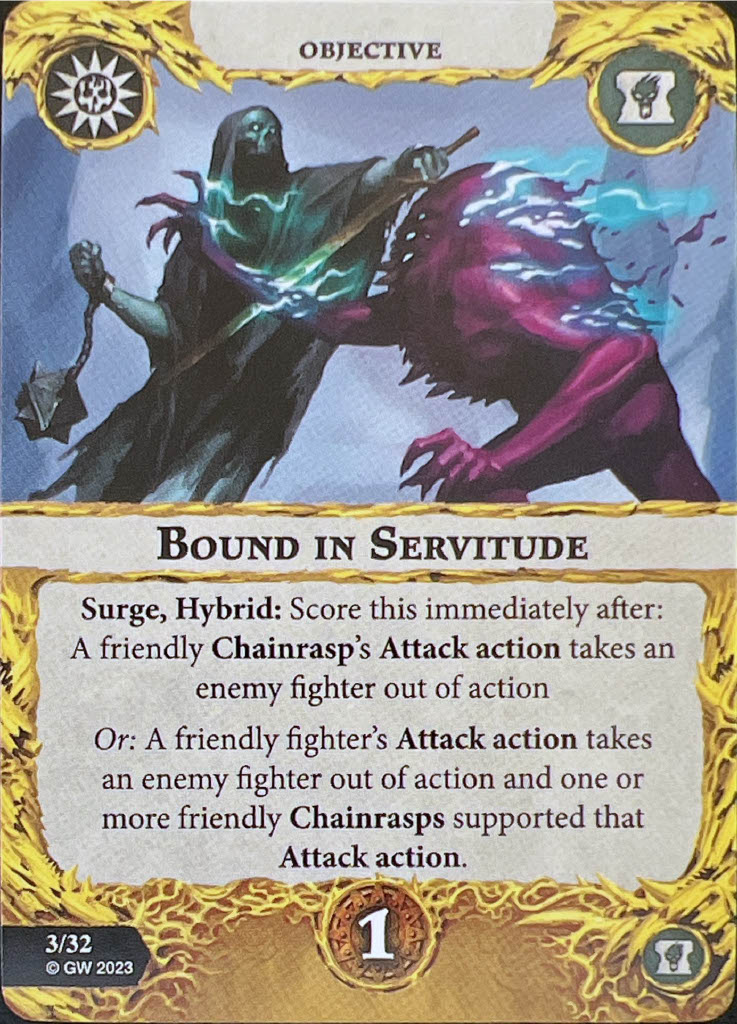

Bound in Servitude is a kill surge for either taking an enemy out of action with a friendly Chainrasp’s attack action or supporting the Wielder’s kill with a Chainrasp supporting. As far as kill surges go, this one’s not too bad given that it is effectively how you plan to play the game anyway. There will be times where Wielder needs to YOLO charge on his own, so it’s not quite as automatic as something like [![]() Savage Slaughter]
Savage Slaughter]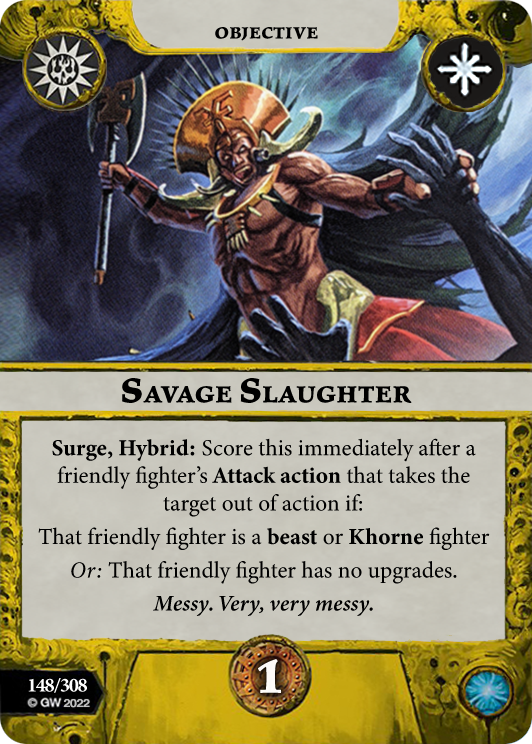 is for Khorne (the gold standard of good 1-glory kill surges), but it’s also less conditional than most, especially since any attack action kills you get outside of your leader will score this as well. I could see this making the cut in a lot of Nemesis decks and even sometimes in Championship.
is for Khorne (the gold standard of good 1-glory kill surges), but it’s also less conditional than most, especially since any attack action kills you get outside of your leader will score this as well. I could see this making the cut in a lot of Nemesis decks and even sometimes in Championship.
Power Ceiling: 2, Consistency: 2
Eager Assistant is this warband’s big 2-glory surge, scored for making your second or subsequent successful supported attack of the phase. For 2 glory, I think I’m teching into this. The warband already has some natural incentives and card support for making supported attacks, but if you start combining this with cards in the universal pool like [![]() Unexpected Ally]
Unexpected Ally]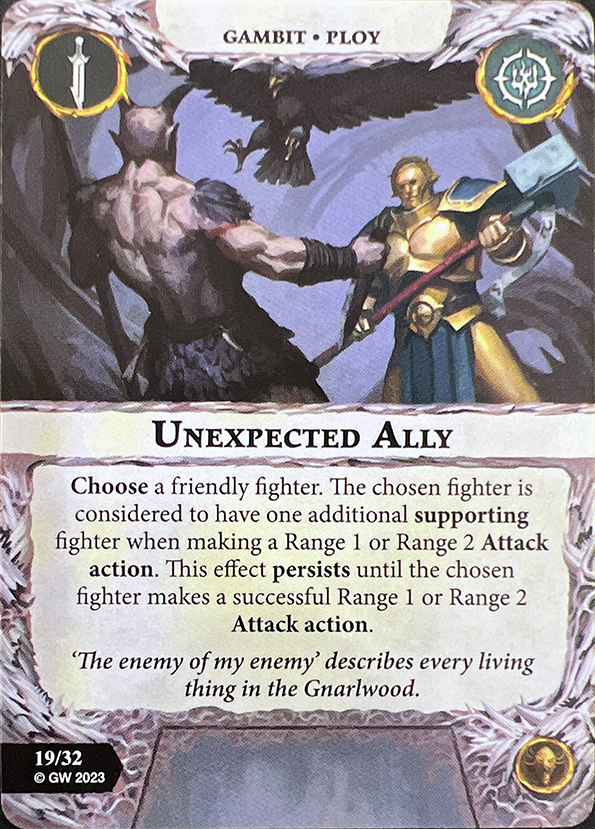 and [
and [![]() Ever-hungry Fiend]
Ever-hungry Fiend]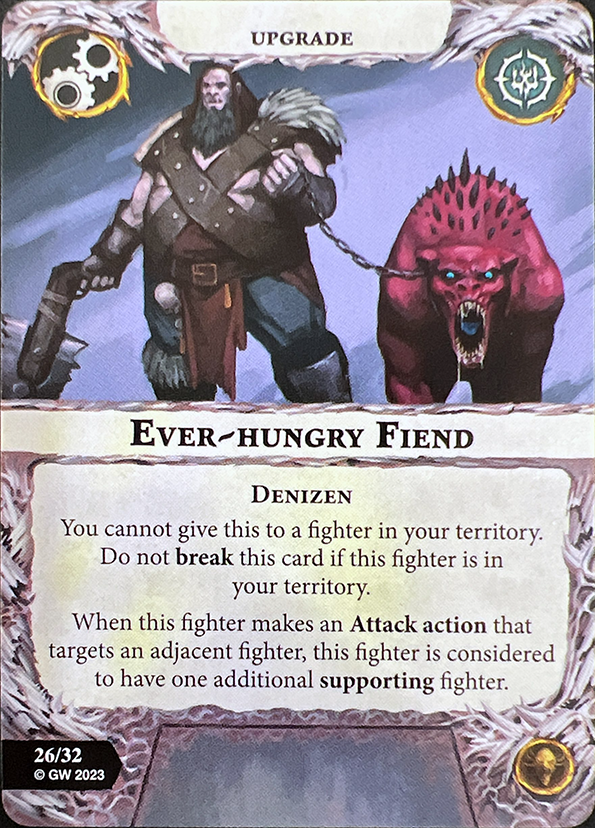 , I think this could be very good. I like that it still requires some interaction on your part though, and it’s certainly not going to be easy to guarantee given that most of the warband swings at Range 1. Big upside but with acceptable risk, I think this is right in line with where you want to see 2-glory surges in terms of design.
, I think this could be very good. I like that it still requires some interaction on your part though, and it’s certainly not going to be easy to guarantee given that most of the warband swings at Range 1. Big upside but with acceptable risk, I think this is right in line with where you want to see 2-glory surges in terms of design.
Power Ceiling: 3, Consistency: 2
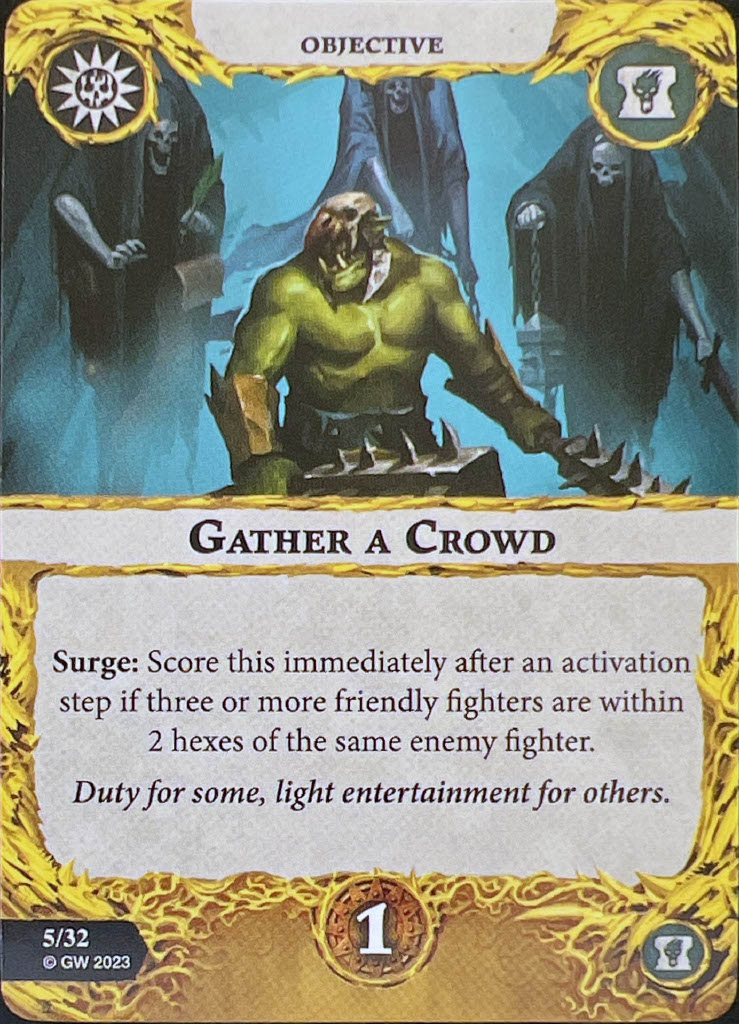
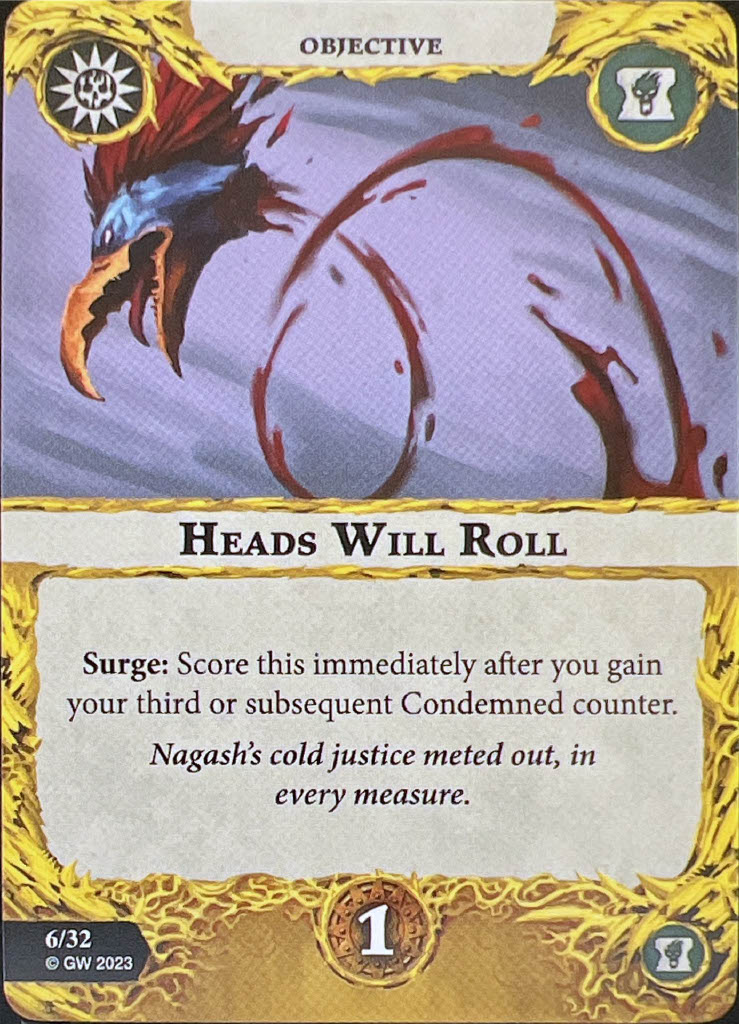
Gather a Crowd echoes [![]() Death Sentence]
Death Sentence]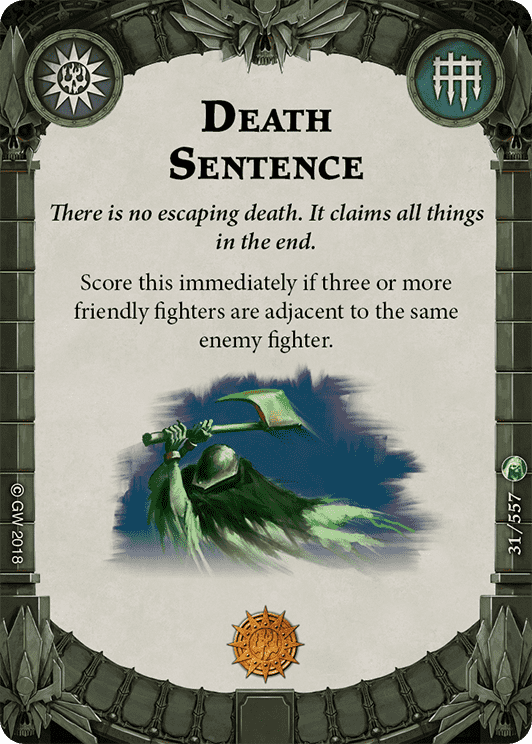 from Thorns while scaling back the adjacency restriction to “within 2 hexes” due to the reduced body count and overall action economy of this warband. The spacing aspect I think should actually be pretty easy to pull off. If you recall back to cards like [
from Thorns while scaling back the adjacency restriction to “within 2 hexes” due to the reduced body count and overall action economy of this warband. The spacing aspect I think should actually be pretty easy to pull off. If you recall back to cards like [![]() Unafraid]
Unafraid]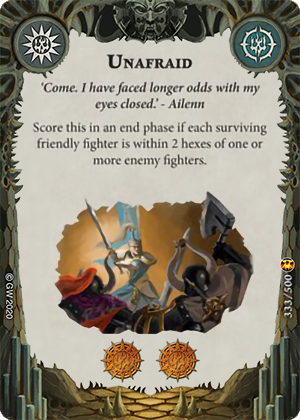 , trying to position around a 2-hex gap was really not so difficult, with, of course, the caveat that you now need to be targeting a single enemy fighter with that spacing. I do like that it doesn’t discourage driveback like so many adjacency objectives do, as you don’t have to yield supports to your opponent just to score this. I think the more common issue will be actually having 3 fighters on the board at the time you have this in hand. Your best bets will probably be situations where your opponent has a couple of fighters grouped up, allowing you to kill one, resurrect a Chainrasp, and meet the condition. There is some decent universal support for this kind of thing with cards like [
, trying to position around a 2-hex gap was really not so difficult, with, of course, the caveat that you now need to be targeting a single enemy fighter with that spacing. I do like that it doesn’t discourage driveback like so many adjacency objectives do, as you don’t have to yield supports to your opponent just to score this. I think the more common issue will be actually having 3 fighters on the board at the time you have this in hand. Your best bets will probably be situations where your opponent has a couple of fighters grouped up, allowing you to kill one, resurrect a Chainrasp, and meet the condition. There is some decent universal support for this kind of thing with cards like [![]() Keep the Forest at Bay]
Keep the Forest at Bay]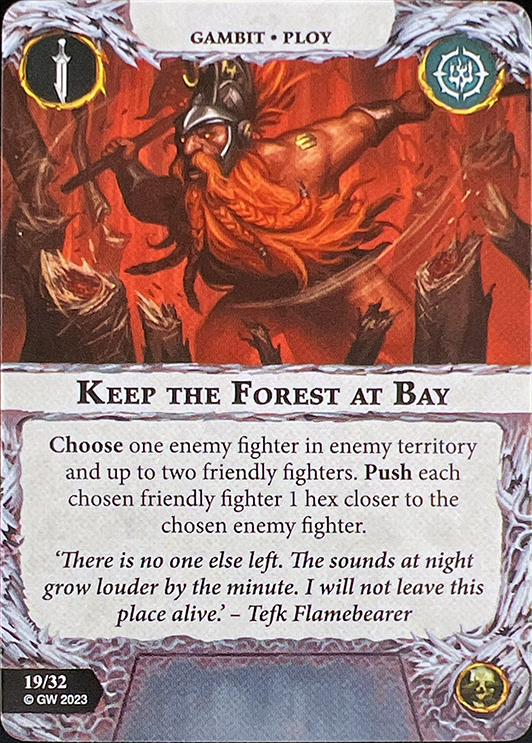 , but I think ultimately it will be held back by the low model count of the warband later in games.
, but I think ultimately it will be held back by the low model count of the warband later in games.
Power Ceiling: 2, Consistency: 2
RIP Flamespooler, our next card is Heads Will Roll, which is a surge scored immediately after you gain your third or subsequent condemned counter. Since there are no ways to gain these counters without killing something, the card name (and art) make plenty of sense. However, since you don’t gain these counters every time you pick up a kill (we’ve already gone over the conditions required to gain them), I’m not sure you can get too excited about this one. Sure, it may work out late game that you’ve got [![]() Ever-hungry Fiend]
Ever-hungry Fiend] or something on Wielder and this is effectively “kill something,” but odds are good it will brick your hand throughout Round 1 and even sometimes into Round 2. The best surges are almost always ones that can seed your glory snowball early, and this one is, outside of only the most optimal scenarios (supporting a kill on a Large fighter that has already been condemned), unlikely to make it into your scored objective pile until Round 2 or later.
or something on Wielder and this is effectively “kill something,” but odds are good it will brick your hand throughout Round 1 and even sometimes into Round 2. The best surges are almost always ones that can seed your glory snowball early, and this one is, outside of only the most optimal scenarios (supporting a kill on a Large fighter that has already been condemned), unlikely to make it into your scored objective pile until Round 2 or later.
Power Ceiling: 1, Consistency: 2
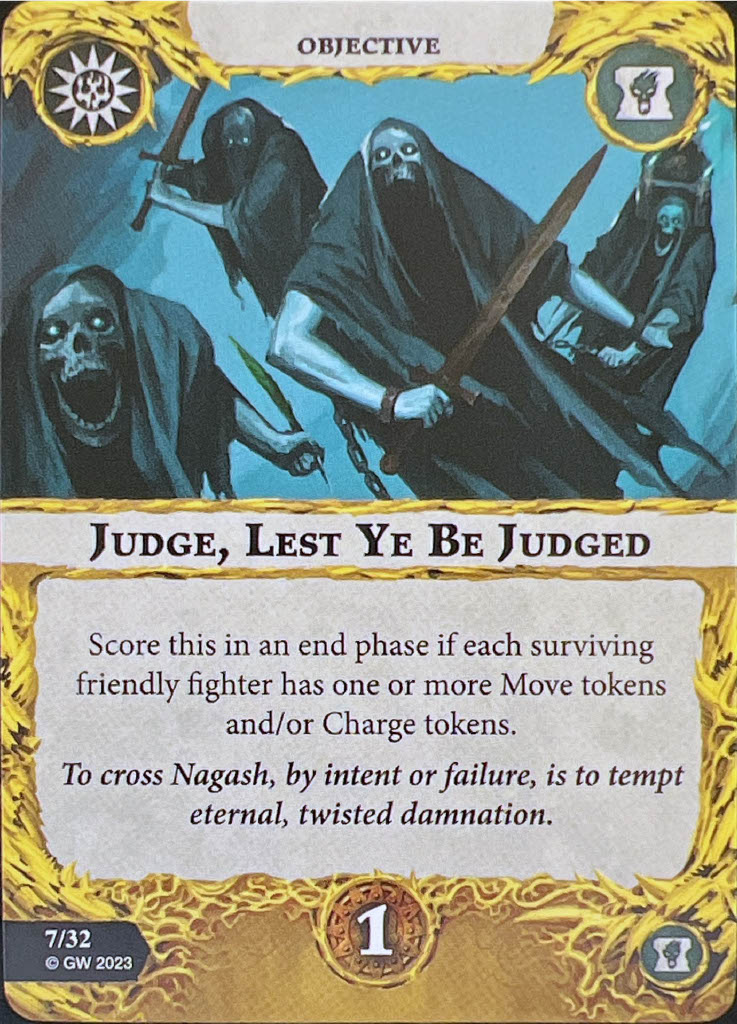

Our next card is quite possibly my favorite card name of all time in Judge, Lest Ye Be Judged. Nagash has basically decided that if you judge someone first and in the manner in which this warband judges people (i.e., decapitating them), they probably won’t be able to judge you back afterward. While this is not a good mantra by which to live your life, it’s great Underworlds advice! Get them before they get you. As a card, the effect is your pretty standard Death [![]() Move or Die]
Move or Die]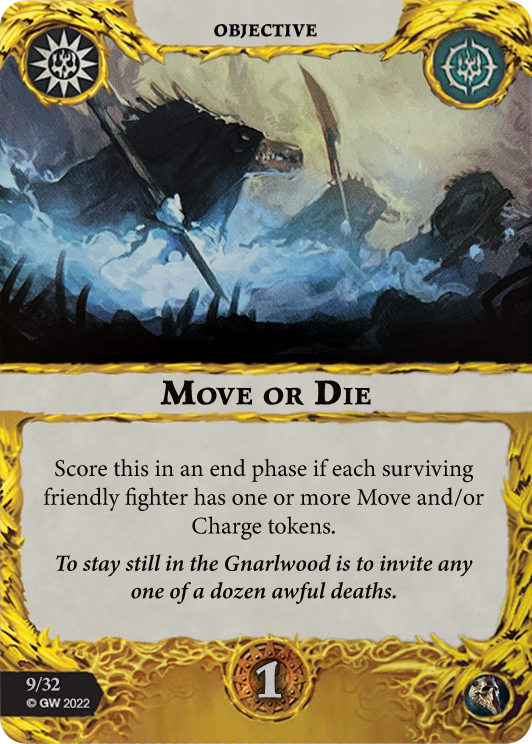 clone, scoring 1 glory in the end phase for each of your friendly fighters having a Move/Charge token. It’s fine here since you will have 4 or fewer fighters and, cheating ahead, there is some power card support for this, but I’m not sure you really want to activate each of your fighters equally. Since you probably get most efficient gameplay out of pulling off multiple attacks with the Wielder in a phase, I think there will be a lot of cases where you don’t want to move your other fighters. Even if you are activating the Sharpener, he will probably be better off sharpening the sword rather than moving or charging. Still, easy enough to do if you want to play for it and it does become more consistent as your fighters die, it’s just another card I probably wouldn’t want in my hand Round 1. Note that you also lose your tokens when you die and are resurrected.
clone, scoring 1 glory in the end phase for each of your friendly fighters having a Move/Charge token. It’s fine here since you will have 4 or fewer fighters and, cheating ahead, there is some power card support for this, but I’m not sure you really want to activate each of your fighters equally. Since you probably get most efficient gameplay out of pulling off multiple attacks with the Wielder in a phase, I think there will be a lot of cases where you don’t want to move your other fighters. Even if you are activating the Sharpener, he will probably be better off sharpening the sword rather than moving or charging. Still, easy enough to do if you want to play for it and it does become more consistent as your fighters die, it’s just another card I probably wouldn’t want in my hand Round 1. Note that you also lose your tokens when you die and are resurrected.
Power Ceiling: 1, Consistency: 2
MORE decapitation art! Off With Their Head! is a kill surge that scores off a friendly leader’s kill and jumps to 2-glory if you happened to take out the enemy leader with that attack. These “your leader makes a kill” surges have historically been very good for big boy warbands and this one seems set to function pretty heavily leader-reliant as well. On top of that, the upside of paying off the [![]() Victorious Duel]
Victorious Duel]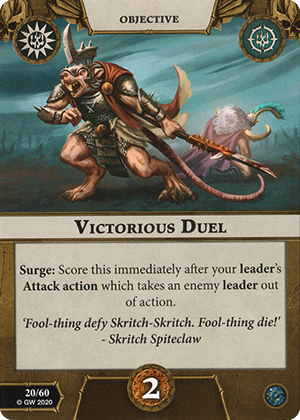 condition without the inherent downside of trying to run that card makes this pretty attractive. I know I typically don’t get too excited about kill surges, but killing with your leader is probably going to be your primary gameplan anyway. Stacking in the burst potential of paying out 2 glory just further increases the value, I really like this one. There will obviously be times where your leader is already dead and you can’t score it, but I think it’s worth the risk.
condition without the inherent downside of trying to run that card makes this pretty attractive. I know I typically don’t get too excited about kill surges, but killing with your leader is probably going to be your primary gameplan anyway. Stacking in the burst potential of paying out 2 glory just further increases the value, I really like this one. There will obviously be times where your leader is already dead and you can’t score it, but I think it’s worth the risk.
Power Ceiling: 3, Consistency: 2
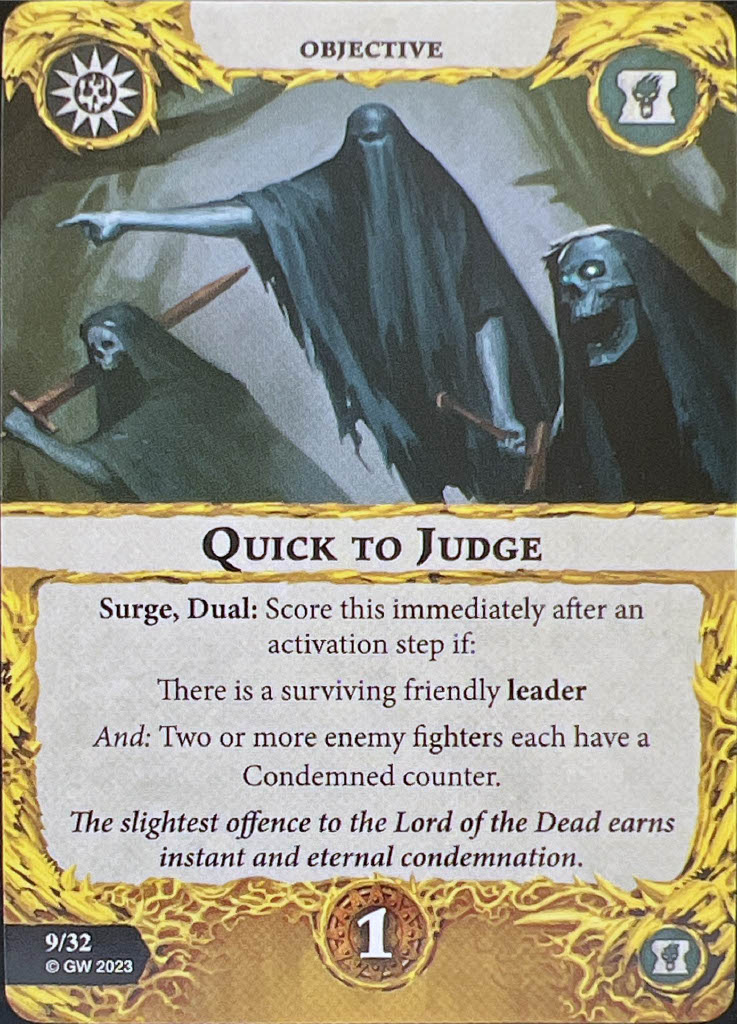
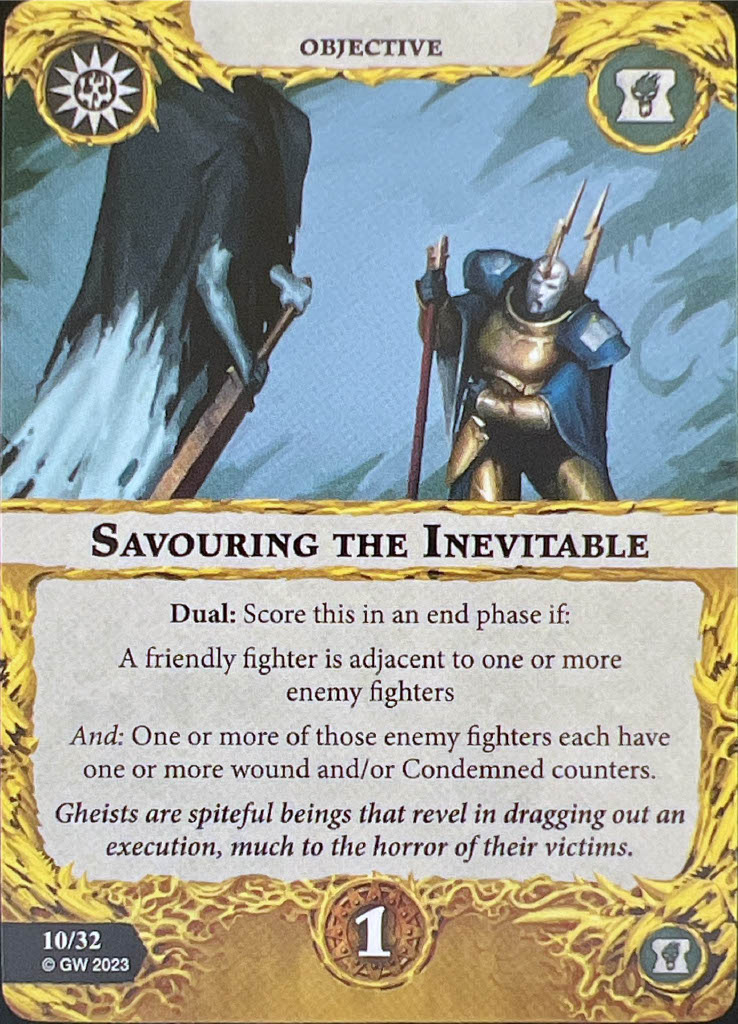
Quick to Judge is a dual surge for having a surviving friendly leader and two or more enemy fighters having condemned counters. Like a lot of recent designs, this is one of those cards that scales in power the fewer universal cards you stack into your deck, as it really leans into the particular “counting” mechanic of the Rivals deck. However, as is the case with most of these, I feel like the power cards which dole out condemned counters are often less desirable when compared to stronger universal effects, since the purpose is as much to give the counter as it is to have an actual gameplay effect. Can you afford to stack in a bunch of those power cards as the card pool expands into Nemesis and further into Championship? Probably not. The upside, such as it is, would be that you can score this with pretty much nothing your opponent you can do about it. Play one gambit, shoot with the Scriptor (doesn’t even need to hit) and boom, you’re good. If there were a bit more payoff for the counters themselves, I’d say you lean into it a bit harder, but there’s really only a couple of objectives and your potential for inspiration, so I don’t think it’s generally going to be worth stacking your deck with these effects. This kind of card is actually very difficult to rate given how easy it could be vs. how easy I think it will be on an optimized Championship deck, so I’m going to stick to the midground.
Power Ceiling: 2, Consistency: 2
Savouring the Inevitable is the third and final condemned counter-based objective for the warband, scoring 1 glory in the end phase for having a friendly fighter adjacent to an enemy fighter with a condemned counter. Again, it’s fine if you are taking the power card package for spreading the counters, but I’ve never liked objectives that require you to maintain adjacency in the end phase. Disincentivizing driveback is playing a dangerous game with regard to your later defensive capabilities, so while you could often control this well enough, I don’t think you want to be leaving fighters at greater risk like this just for 1 glory.
Power Ceiling: 1, Consistency: 2
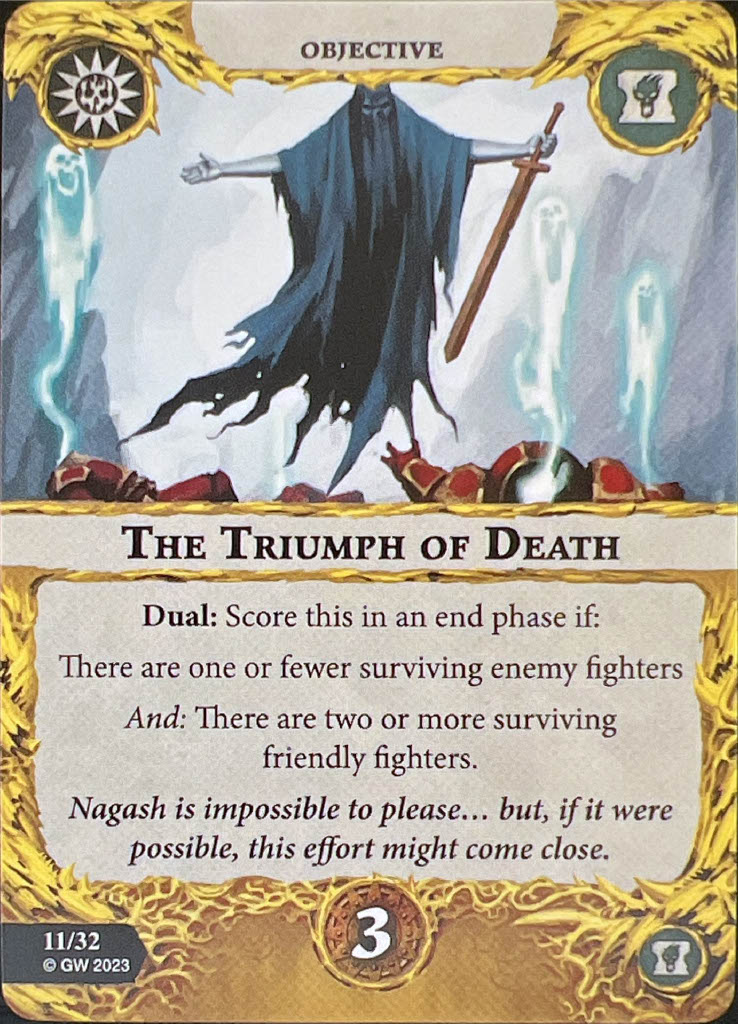

Recycling yet another common Death card, we have The Triumph of Death as an [![]() Absolute Dominance]
Absolute Dominance]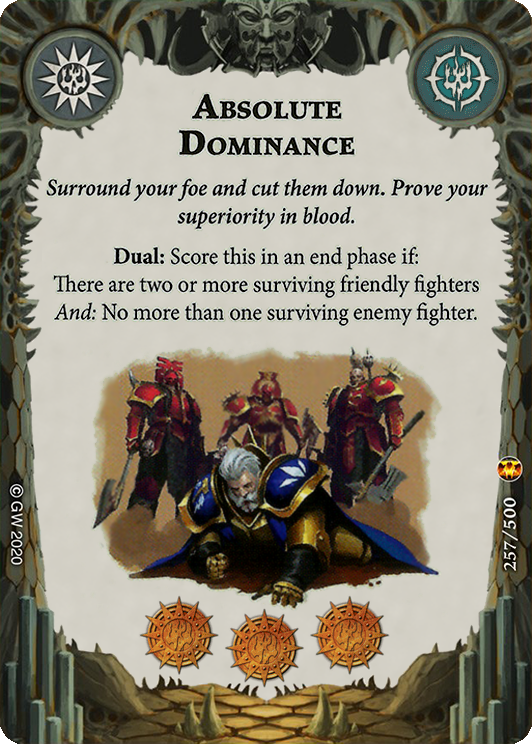 reprint (Sons of Velmorn got it too). Having resurrection potential definitely can make this kind of card more attractive, especially on a warband that doesn’t seem like it’s really designed to do much besides killing. Warbands that can make use of their big 3-glory bombs can build entire gameplans around them in the right circumstances (think [
reprint (Sons of Velmorn got it too). Having resurrection potential definitely can make this kind of card more attractive, especially on a warband that doesn’t seem like it’s really designed to do much besides killing. Warbands that can make use of their big 3-glory bombs can build entire gameplans around them in the right circumstances (think [![]() Collateral Damage]
Collateral Damage]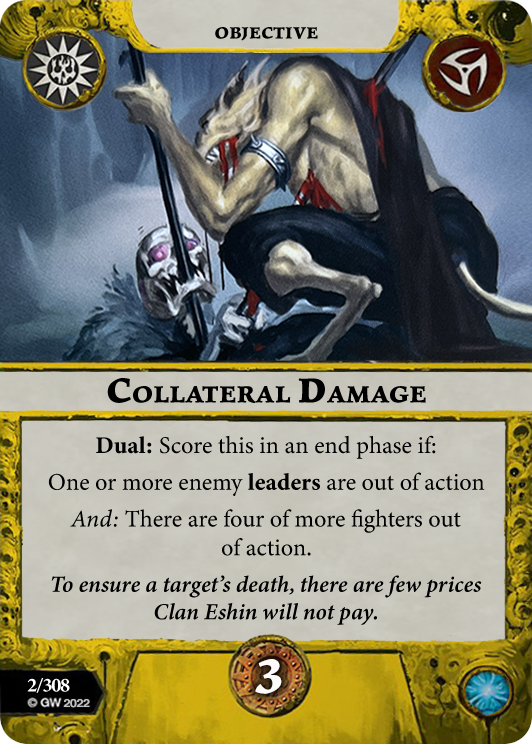 and [
and [![]() Grim Satisfaction]
Grim Satisfaction]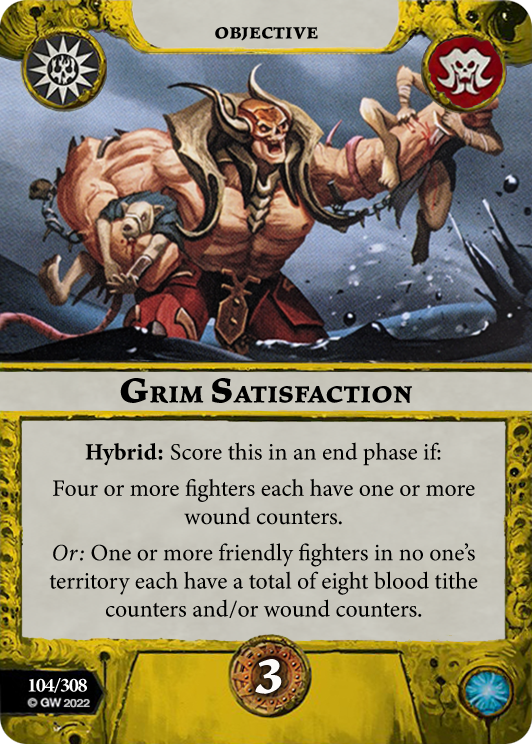 ). Can these guys pull off aggro resurrection? Maybe, but it’s definitely going to be very matchup-dependent.
). Can these guys pull off aggro resurrection? Maybe, but it’s definitely going to be very matchup-dependent.
Power Ceiling: 3, Consistency: 1
Tools of Death is our final objective and rewards you 2 glory for having 3 or more friendly fighters each with 1 or more upgrades. It’s funny that we love these cards when you can put all 3 upgrades on one fighter but balk when they want us to spread out the same number of upgrades. However, the obvious benefits to stacking multiple upgrades on one or two fighters as opposed to spreading them around tend to get in the way of making cards like this particularly useful and that’s no exception here. While you might not mind slapping some upgrades on the Bearer, the general vibe seems to be to beef up the Wielder and go nuts. Furthermore, it’s always hard to bank on having so many different fighters still be alive at the time you want to score this. I think when you have a fighter so potent and most of your other fighters are so unimpressive, it’s hard to, for the most part, take upgrades in your deck other than those you intend to give to the big guy. Sure, you can sort of audible into one of your Chainrasps here, but, while some warbands have the luxury of a Plan A and Plan B, this seems very much like a warband that has a Plan A and then hits the “Reset Board” button when it goes awry. I don’t think it’s worth diverging from the leader-centric theme of the warband just to score this, even if it technically is just as easy of a glory multiplier as cards like [![]() Loaded with Plunder]
Loaded with Plunder]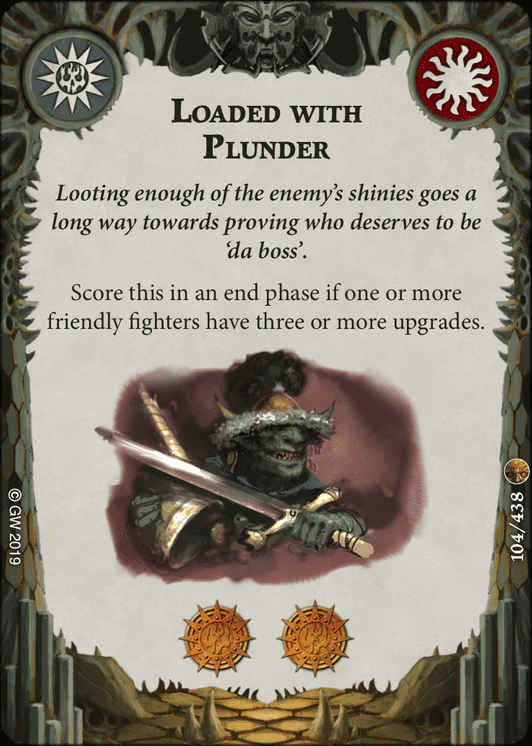 or [
or [![]() Pursuit of Excellence]
Pursuit of Excellence]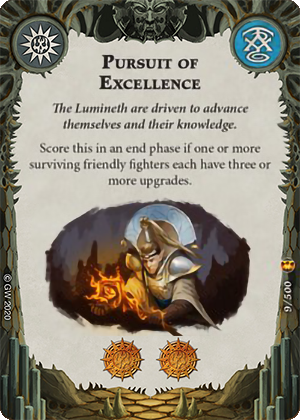 . Major points for the poem in the flavor text though.
. Major points for the poem in the flavor text though.
Power Ceiling: 2, Consistency: 2
Our Favorites
- Mark: Off With Their Head!
- Aman: Eager Assistant
- Zach: Bound in Servitude
Gambits
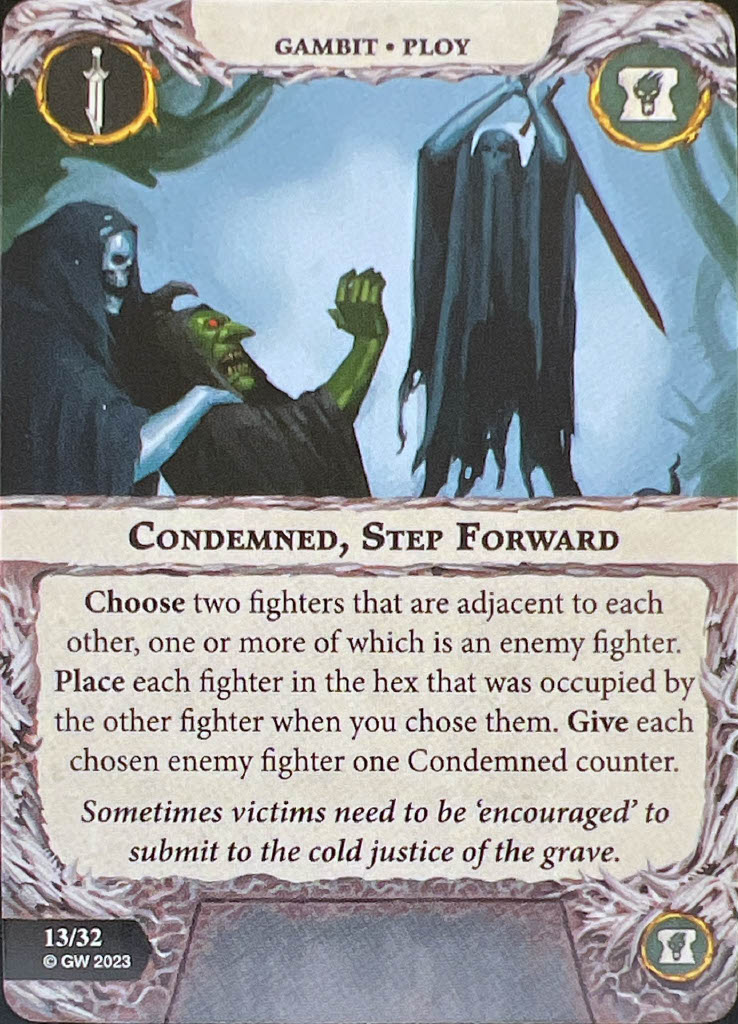
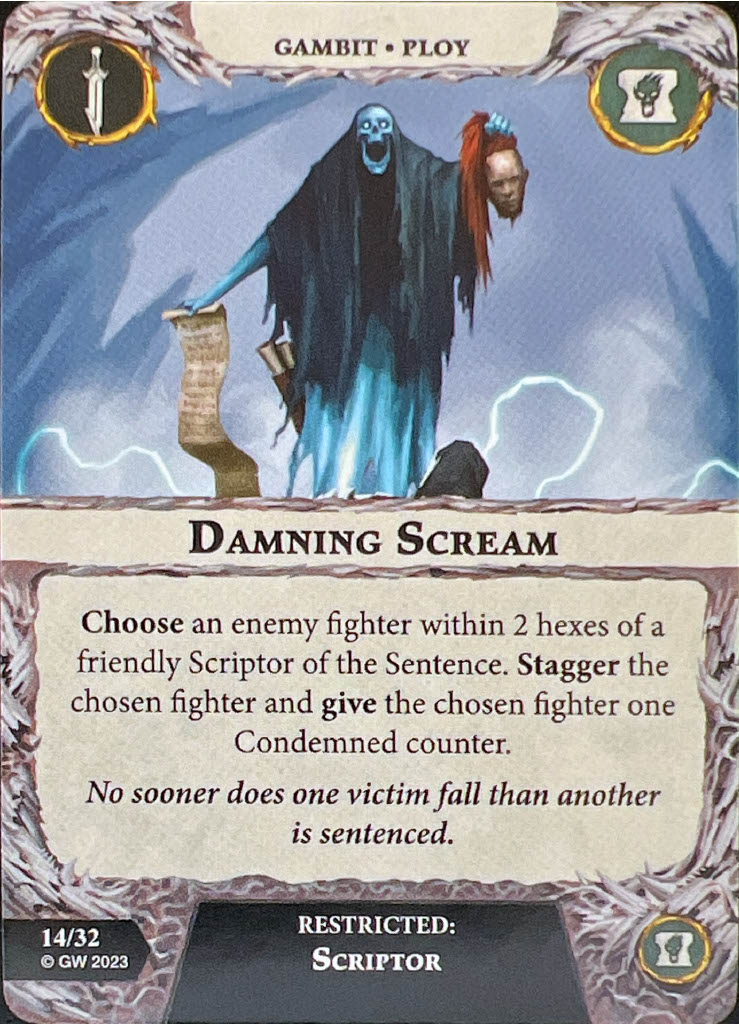
Starting off strong here, we have Condemned, Step Forward. [![]() Confusion]
Confusion]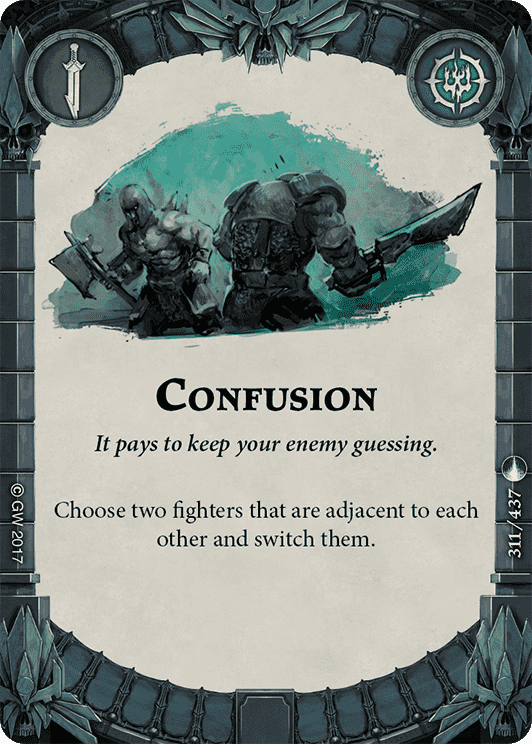 plus gives enemy fighters condemned counters? Sign me up. Now, it’s not quite the same since you have to choose at least one enemy fighter, but realistically it is uncommon to be only swapping friendly fighters with that card unless you are Spiteclaw’s Swarm. Oftentimes it finds the most use when stealing feature tokens from enemy fighters, but it can also be a cute way to take a protected enemy fighter and drop them into a suddenly vulnerable position. Interestingly enough, if you choose two enemy fighters, you can actually score Quick to Judge with just a single power card. While I don’t think this warband will be aiming to pull off that much positional scoring, which is usually where a card like this shines the most, the disruption potential and overall value of a card like this makes it worth considering in just about every deck.
plus gives enemy fighters condemned counters? Sign me up. Now, it’s not quite the same since you have to choose at least one enemy fighter, but realistically it is uncommon to be only swapping friendly fighters with that card unless you are Spiteclaw’s Swarm. Oftentimes it finds the most use when stealing feature tokens from enemy fighters, but it can also be a cute way to take a protected enemy fighter and drop them into a suddenly vulnerable position. Interestingly enough, if you choose two enemy fighters, you can actually score Quick to Judge with just a single power card. While I don’t think this warband will be aiming to pull off that much positional scoring, which is usually where a card like this shines the most, the disruption potential and overall value of a card like this makes it worth considering in just about every deck.
Power Ceiling: 3, Consistency: 2
Damning Scream allows you to stagger and give one condemned counter to an enemy fighter within 2 hexes of the Scriptor. Stagger is fine, but this gambit being restricted to just one of your fighters makes it a suspect inclusion in a constructed deck. If the restriction were just to Chainrasps instead, maybe you start to consider it, but, even then, there are more powerful accuracy gambits like [![]() King of the Deeps]
King of the Deeps]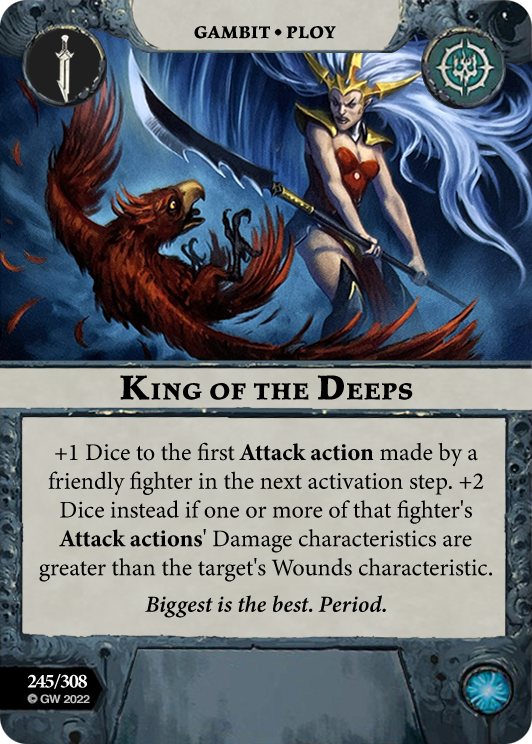 you could take here instead. At least being able to resurrect him can increase the dependability of the card and set up the positioning needed to use it, but it may actually be more valuable as salvage fodder.
you could take here instead. At least being able to resurrect him can increase the dependability of the card and set up the positioning needed to use it, but it may actually be more valuable as salvage fodder.
Power Ceiling: 1, Consistency: 2
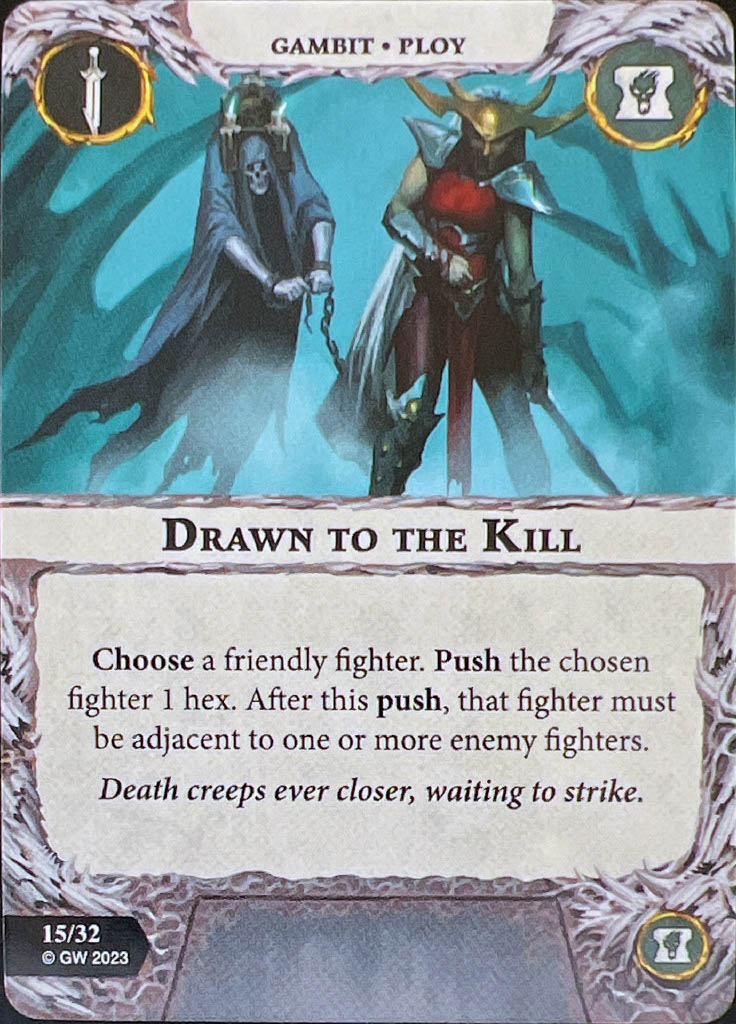
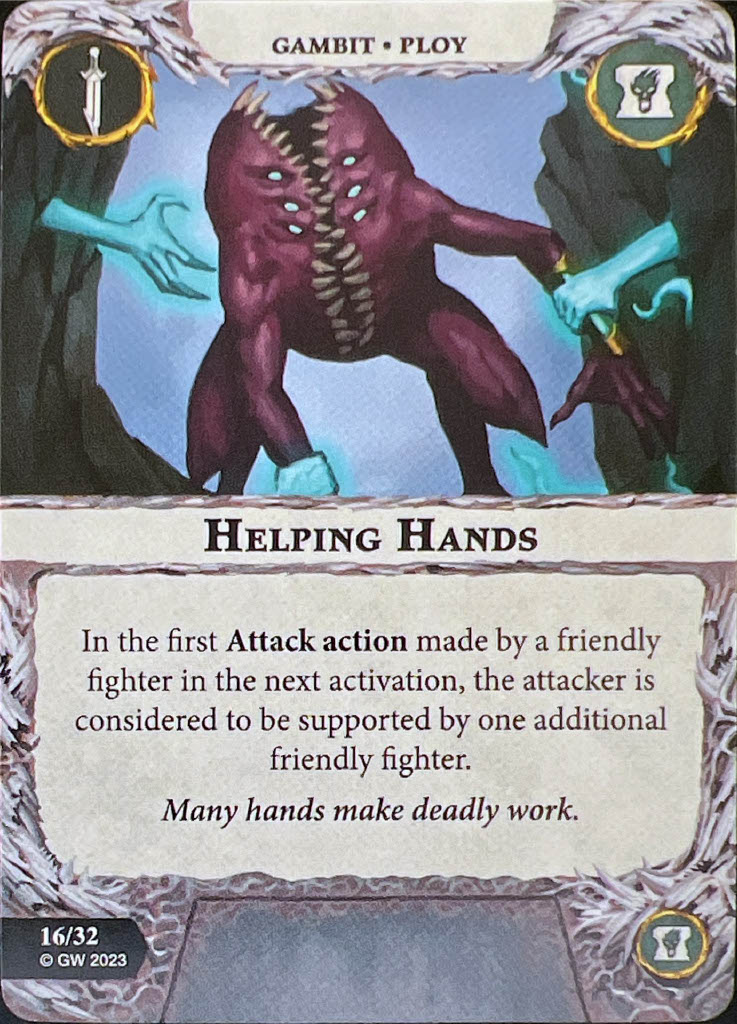
Drawn to the Kill is a limited [![]() Sidestep]
Sidestep]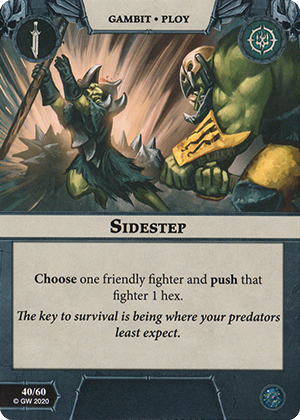 that requires your fighter to end the push adjacent to an enemy fighter. When we have this severe of a restriction on the use case for the push, I think the reward needs to be higher. Typically I like the construct of “push 1 towards the nearest enemy, or push 2 if you are adjacent to an enemy fighter after the push.” Given how much Range 1 we have here, I think you really want to be able to push from further away to make sure you are able to set up your charges. I’m not even sure this one makes the cut in Nemesis.
that requires your fighter to end the push adjacent to an enemy fighter. When we have this severe of a restriction on the use case for the push, I think the reward needs to be higher. Typically I like the construct of “push 1 towards the nearest enemy, or push 2 if you are adjacent to an enemy fighter after the push.” Given how much Range 1 we have here, I think you really want to be able to push from further away to make sure you are able to set up your charges. I’m not even sure this one makes the cut in Nemesis.
Power Ceiling: 1, Consistency: 2
Helping Hands is a [![]() Swarming Strike]
Swarming Strike]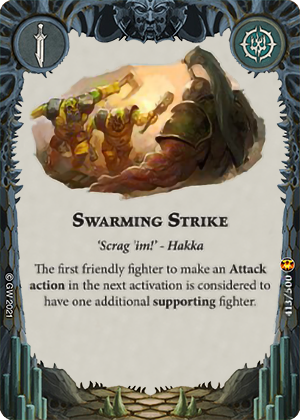 reprint and I quite like it for this warband. Having no Range restriction is nice for those times you might use this from further away than Range 1, but the support on its own can be clutch beyond just the accuracy. Being able to pick up an extra condemned counter for making that supported kill might be the difference between earlier and later inspiration. This is more along the lines of what you’d want for cards that can help you generate counters. While it does help accomplish that, it has a strong effect at its base for impacting the actual game rather than just a number you are counting up on the side. Additionally, there are some nice support synergies in the universal pool with cards like [
reprint and I quite like it for this warband. Having no Range restriction is nice for those times you might use this from further away than Range 1, but the support on its own can be clutch beyond just the accuracy. Being able to pick up an extra condemned counter for making that supported kill might be the difference between earlier and later inspiration. This is more along the lines of what you’d want for cards that can help you generate counters. While it does help accomplish that, it has a strong effect at its base for impacting the actual game rather than just a number you are counting up on the side. Additionally, there are some nice support synergies in the universal pool with cards like [![]() Loyal Allies]
Loyal Allies]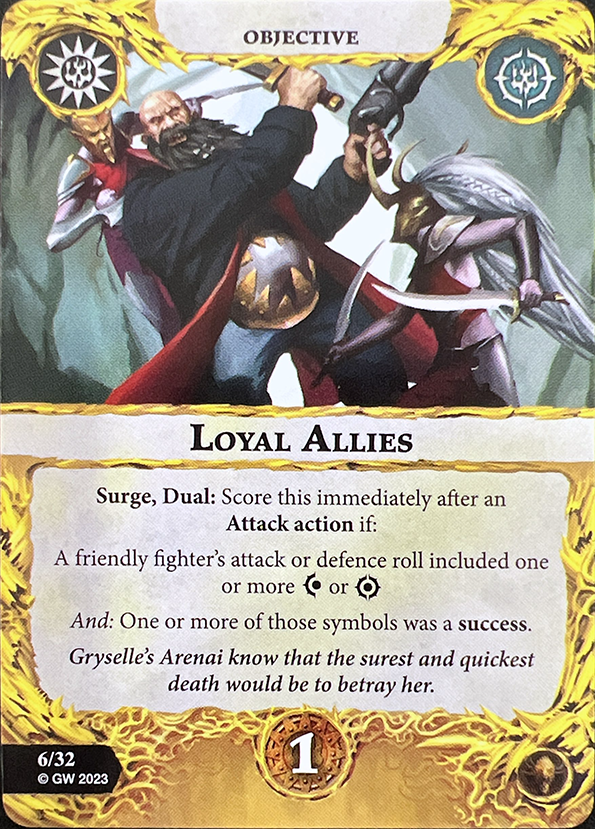 or [
or [![]() Unfair Fight]
Unfair Fight]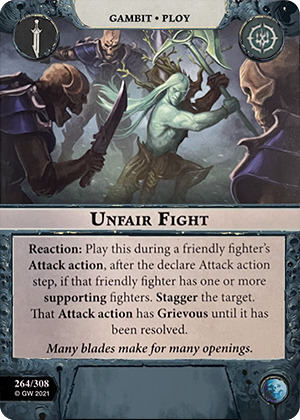 that you could potentially unlock.
that you could potentially unlock.
Power Ceiling: 2, Consistency: 3
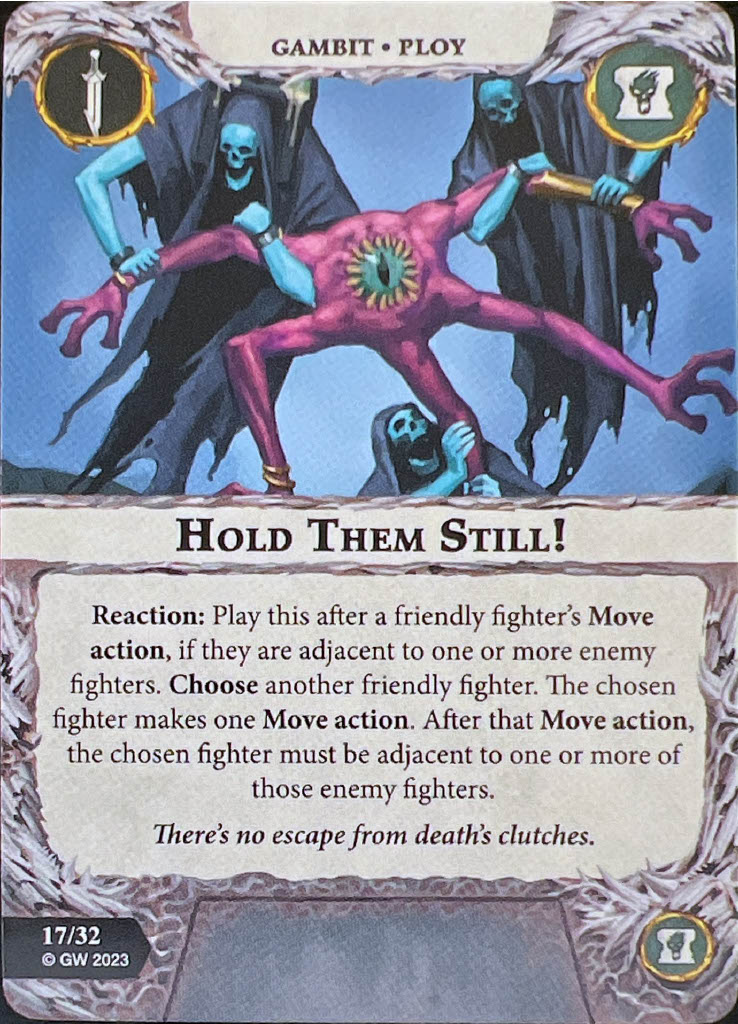

Hold Them Still! is a pseudo-[![]() Cautious Manoeuvre]
Cautious Manoeuvre]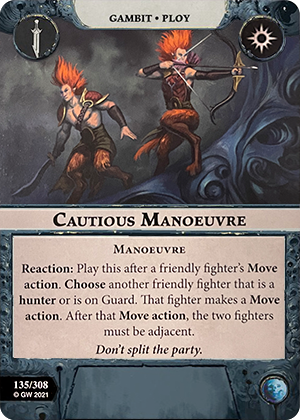 that allows you to, after you make a move action where your fighter is adjacent to an enemy fighter, move in a second friendly fighter as well. The most obvious drag-in here would be the Bearer, as he can add cleave and negate guard, but the support is just nice in general for this warband. It’s also a way to help cheat out cards like Gather a Crowd or Judge, Lest Ye Be Judged, I like it. I’ve used Mortek Advance enough to know that stacking in supports and movement efficiency is a powerful effect, I think this is probably going to make your 10, although there will obviously be situations where nobody else is in range or you have only one fighter surviving.
that allows you to, after you make a move action where your fighter is adjacent to an enemy fighter, move in a second friendly fighter as well. The most obvious drag-in here would be the Bearer, as he can add cleave and negate guard, but the support is just nice in general for this warband. It’s also a way to help cheat out cards like Gather a Crowd or Judge, Lest Ye Be Judged, I like it. I’ve used Mortek Advance enough to know that stacking in supports and movement efficiency is a powerful effect, I think this is probably going to make your 10, although there will obviously be situations where nobody else is in range or you have only one fighter surviving.
Power Ceiling: 2, Consistency: 2
Just in Case is another restrictive [![]() Sidestep]
Sidestep] , this one allowing you to push 1 hex towards the nearest enemy fighter with a wound and/or condemned counter. Not being able to surpass the bar for [
, this one allowing you to push 1 hex towards the nearest enemy fighter with a wound and/or condemned counter. Not being able to surpass the bar for [![]() Sidestep]
Sidestep] as a push pretty much automatically disqualifies a card from making it into a Championship deck. Even in the more limited formats, needing to satisfy some other condition just to unlock a 1-hex push that you can’t even have full control over directionally is difficult for the value you are getting back. Very similar feelings here as for Drawn to the Kill.
as a push pretty much automatically disqualifies a card from making it into a Championship deck. Even in the more limited formats, needing to satisfy some other condition just to unlock a 1-hex push that you can’t even have full control over directionally is difficult for the value you are getting back. Very similar feelings here as for Drawn to the Kill.
Power Ceiling: 1, Consistency: 2
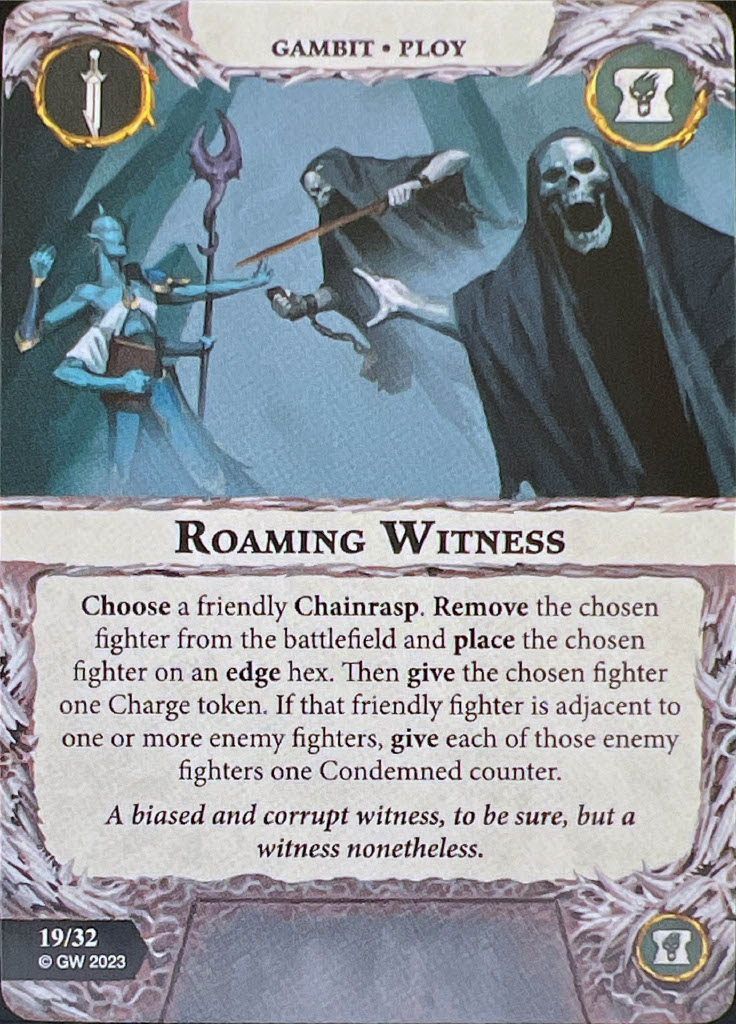
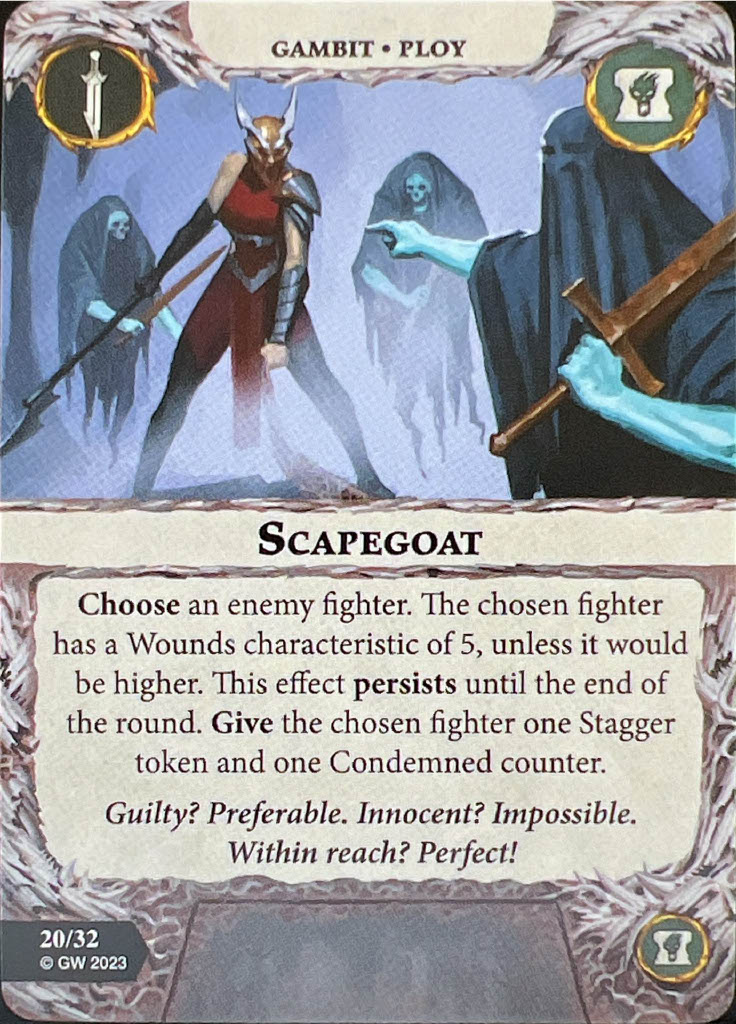
Roaming Witness allows you to essentially teleport a friendly Chainrasp into an edge hex and give each adjacent enemy fighter a condemned counter at the cost of a charge token. Notably, the Chainrasp could already have a Charge token when they are selected, as there are no token restrictions there. Definitely some [![]() Sudden Appearance]
Sudden Appearance]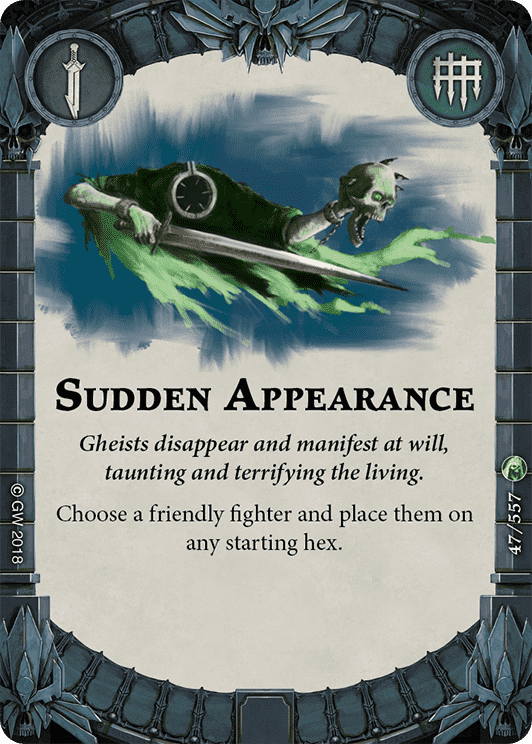 vibes here, although obviously not quite so potent. It’s a nice way to add some surprise support to an attack or even just get an at-risk Chainrasp out of harm’s way. Additionally, it is another way to give a token to a Chainrasp without necessarily having to activate them for help with Judge, Lest Ye Be Judged or cards like [
vibes here, although obviously not quite so potent. It’s a nice way to add some surprise support to an attack or even just get an at-risk Chainrasp out of harm’s way. Additionally, it is another way to give a token to a Chainrasp without necessarily having to activate them for help with Judge, Lest Ye Be Judged or cards like [![]() Embraced Savagery]
Embraced Savagery]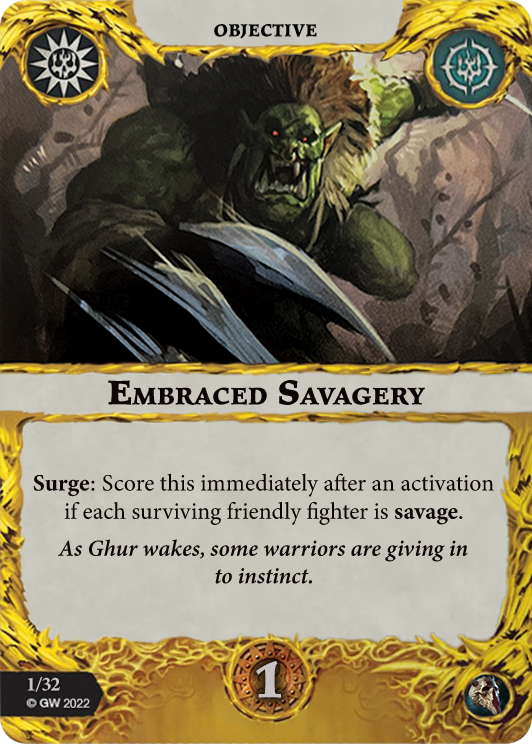 /[
/[![]() Fully Committed]
Fully Committed]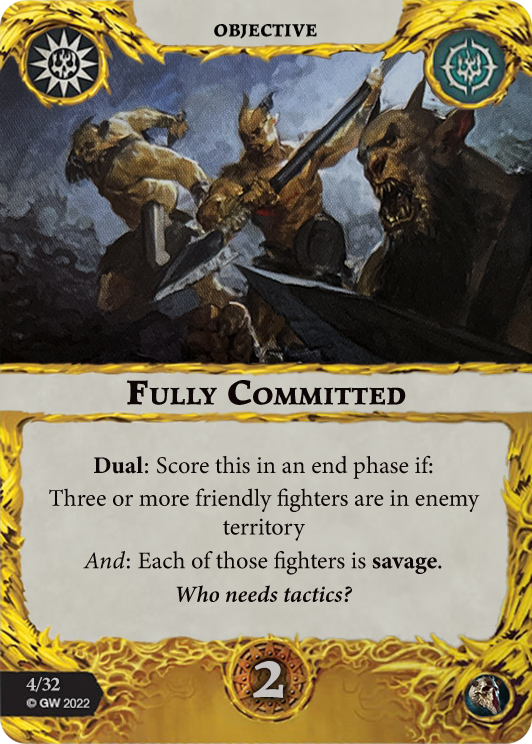 , if you elect to go with Tooth and Claw as your plot deck. It can even open up the potential to abuse the new charge rule with Wielder. Definitely a multitude of uses for the card, but it will still often find itself competing with push and accuracy gambits once you dip into Championship. Should provide some decent play in Nemesis and Rivals though and will maybe even sneak into certain Championship builds. Just be mindful of token organization during setup if you expect your opponent to want to scramble their fighters onto them. If you are careful during placement, you can help ensure that where they want to be standing lines up next to edge hexes.
, if you elect to go with Tooth and Claw as your plot deck. It can even open up the potential to abuse the new charge rule with Wielder. Definitely a multitude of uses for the card, but it will still often find itself competing with push and accuracy gambits once you dip into Championship. Should provide some decent play in Nemesis and Rivals though and will maybe even sneak into certain Championship builds. Just be mindful of token organization during setup if you expect your opponent to want to scramble their fighters onto them. If you are careful during placement, you can help ensure that where they want to be standing lines up next to edge hexes.
Power Ceiling: 2, Consistency: 2
Scapegoat allows you to make an enemy fighter have a Wounds characteristic of 5 (unless it would otherwise be higher) for the rest of the round, staggering them and giving them a condemned counter as well. You might think it would be odd to want to increase the Wounds total of your opponent’s fighter, but there’s actually a good bit of synergy here. Opening up the opportunity to claim 2 condemned counters off that fighter (maybe even 3 if you also have support) can ease your inspiration while also increasing the bounty you receive for killing that fighter. Similarly, we have a lot of upgrades that now break if a fighter becomes large and you could potentially brick some very powerful effects with this gambit, so that your opponent has not only lost a powerful card, but also wasted their glory. With how much damage Wielder does anyway, I think it’s fine to risk beefing up that fighter for all the benefits you reap from it on the other end. I would probably just avoid using this on dangerous fighters like Aemos though, as you don’t necessarily want to risk your opponent making you pay for the increased survivability. Still, I think this is probably the best gambit in the set.
Power Ceiling: 3, Consistency: 3
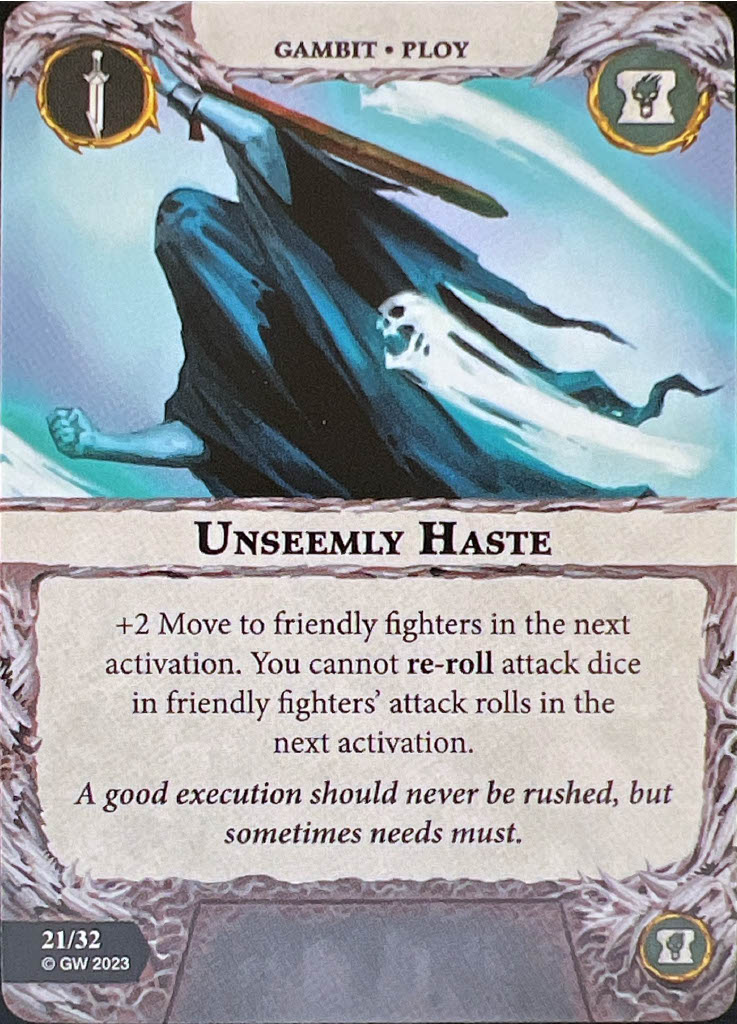
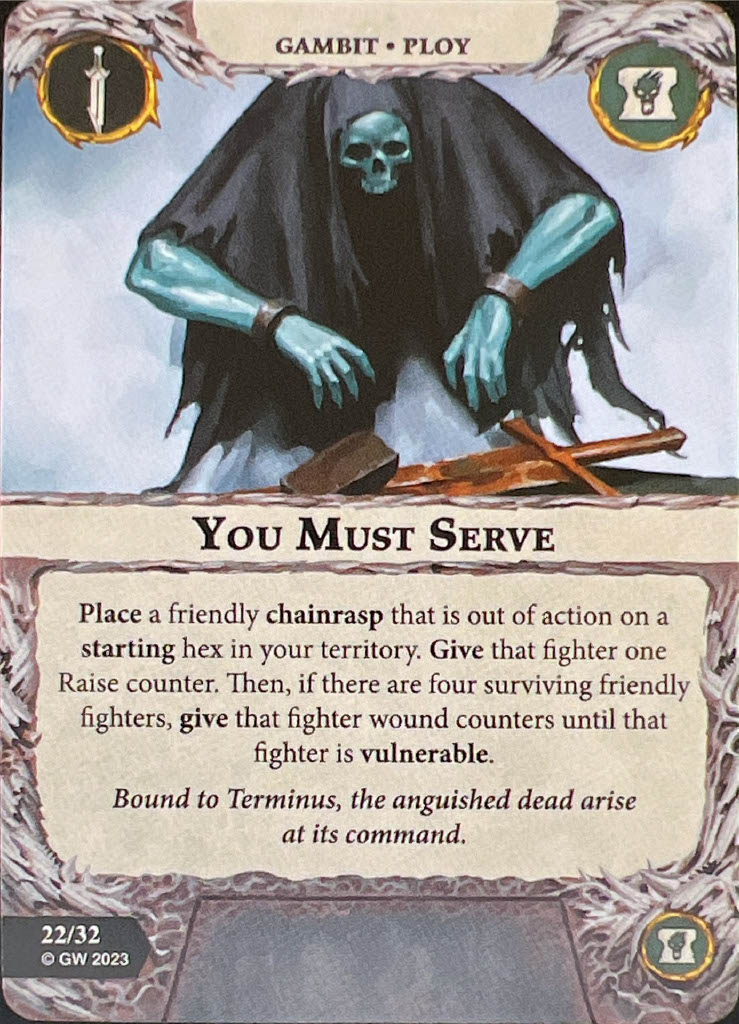
Unseemly Haste grants you that nice [![]() Spectral Wings]
Spectral Wings]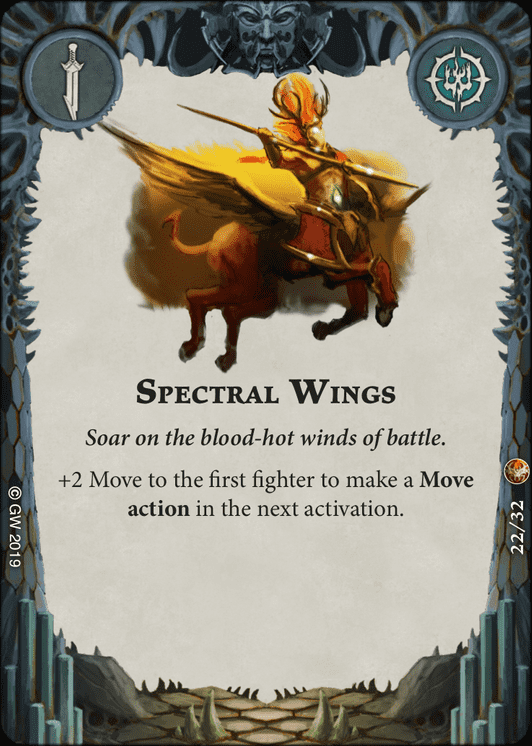 +2 Move boost, although the cost of not being able to re-roll your attack dice is a pretty big downside considering that is where most of the warband’s accuracy tech lies. While most of these cards in the universal pool come with some kind of downside these days, I think I’d rather just pack in some pushes if I feel like I need extra mobility.
+2 Move boost, although the cost of not being able to re-roll your attack dice is a pretty big downside considering that is where most of the warband’s accuracy tech lies. While most of these cards in the universal pool come with some kind of downside these days, I think I’d rather just pack in some pushes if I feel like I need extra mobility.
Power Ceiling: 1, Consistency: 2
Last, but not least, we have You Must Serve, the nearly obligatory Death resurrection gambit. While this only works on Chainrasps, note that it is not leader or otherwise fighter-restricted, meaning you can play it even if your leader and/or your entire warband is out of action. The vulnerability if you have 4 surviving fighters is really not such a bad downside considering how many options you have to benefit from resurrection on top of the obviously powerful effect of bringing back an extra body. Double down with [![]() Partial Resurrection]
Partial Resurrection] and the Wielder’s ability and you’ve got a pretty consistent resurrection package. Very good card, should find its way into every Headsmen’s Curse deck.
and the Wielder’s ability and you’ve got a pretty consistent resurrection package. Very good card, should find its way into every Headsmen’s Curse deck.
Power Ceiling: 3, Consistency: 3
Our Favorites
- Mark: Scapegoat
- Aman: You Must Serve
- Zach: Roaming Witness
Upgrades
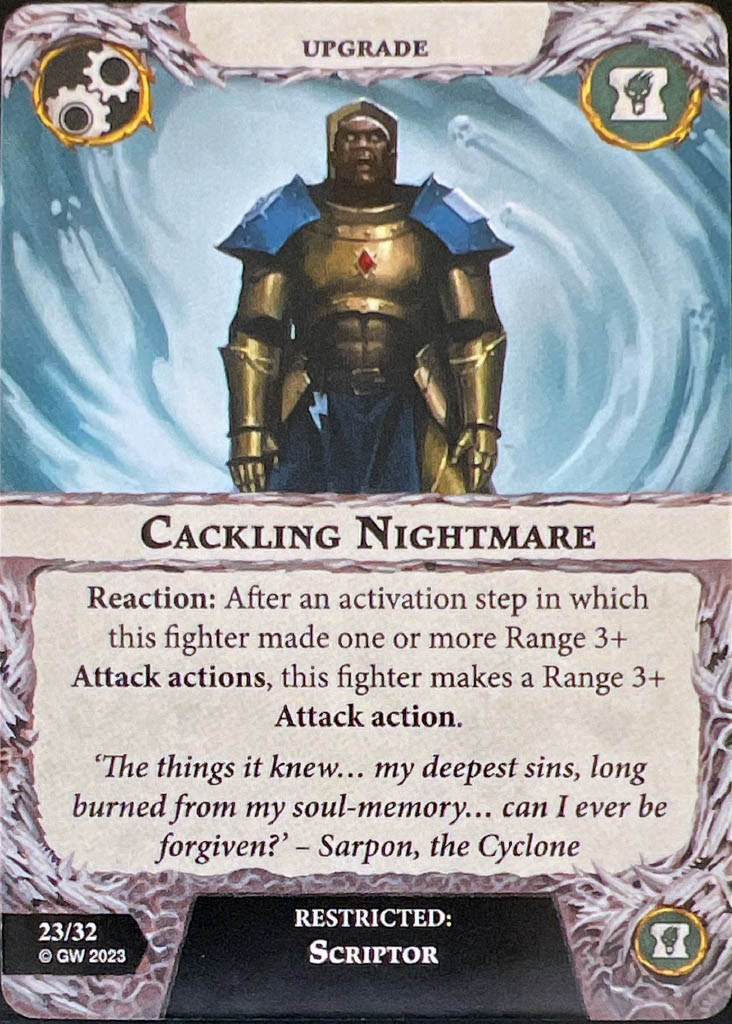
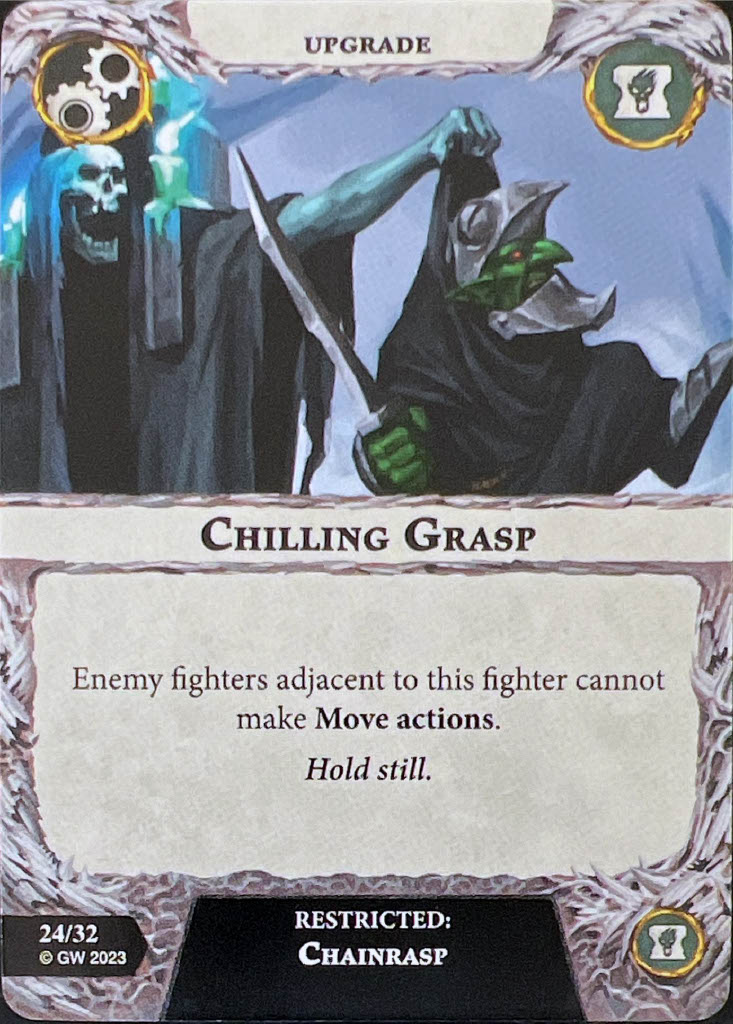
Cackling Nightmare is our first upgrade and is restricted to the Scriptor. It’s your typical [![]() Rapid Reload]
Rapid Reload] type of upgrade for your Range 3 fighter, which is all well and good. With [
type of upgrade for your Range 3 fighter, which is all well and good. With [![]() Gloryseeker]
Gloryseeker]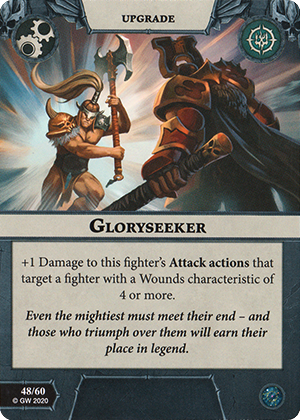 or something you could suddenly become a threat to 4-Wound fighters, especially due to the inspired attack action having stagger to set up an easier time hitting the second attack. However, and this is quite a bummer, the reaction timing actually conflicts with that of Condemn. Either you shoot once and put down the counter, or shoot twice and get 0 counters. Don’t love that, especially in the context of what I said earlier about wanting my upgrades to work with my leader.
or something you could suddenly become a threat to 4-Wound fighters, especially due to the inspired attack action having stagger to set up an easier time hitting the second attack. However, and this is quite a bummer, the reaction timing actually conflicts with that of Condemn. Either you shoot once and put down the counter, or shoot twice and get 0 counters. Don’t love that, especially in the context of what I said earlier about wanting my upgrades to work with my leader.
Power Ceiling: 2, Consistency: 1
Chilling Grasp is restricted to your Chainrasps and prevents enemy fighters adjacent to the equipped fighter from making move actions. This is a pretty cute way to deny a particular threat from charging off and hitting a more important fighter, but it does come with the cost that they can just try to smack you first. Best case, maybe you can use this to prevent that threat from coming after your leader or something for the final activation of the round. I suppose it’s also ok if you really want that enemy fighter to stay exactly where they are for another activation (like if they might’ve wanted to run away before you score Gather a Crowd), but the fact that your opponent could potentially just push out of the effect makes it relatively easy to break, in addition to the fact that you are yielding support to a different enemy fighter that might attack you. Probably leaving this one at home.
Power Ceiling: 2, Consistency: 1
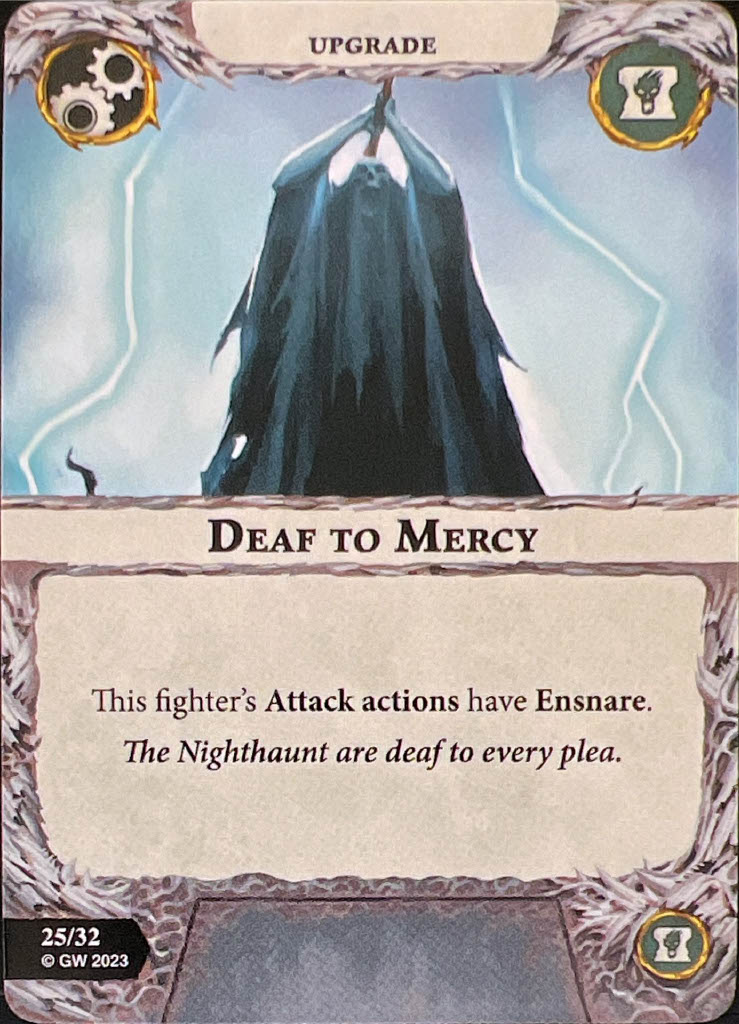
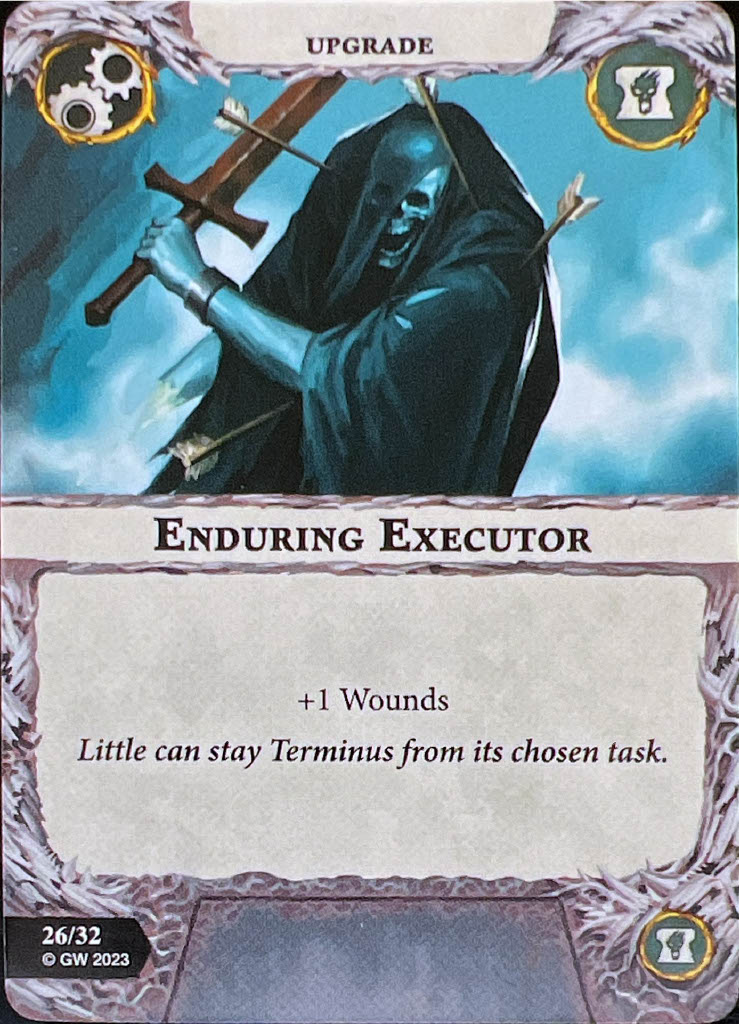
Deaf to Mercy gives you ensnare… Yep, that’s it. Even if you happen to run into like inspired Otapatl, a re-roll or +1 Dice is just as good, so that’s where you want to focus your accuracy upgrades, if possible. Those accuracy buffs will be valuable in every matchup, as opposed to just ones against Dodge fighters.
Power Ceiling: 1, Consistency: 1
Enduring Executor is +1 Wounds. That’s it, but that’s a good effect! Your leader is large anyway, so you may as well improve his survivability with this and potentially also [![]() Great Fortitude]
Great Fortitude]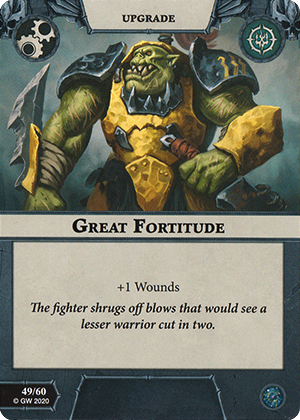 , especially in such a ping-heavy meta.
, especially in such a ping-heavy meta.
Power Ceiling: 2, Consistency: 3
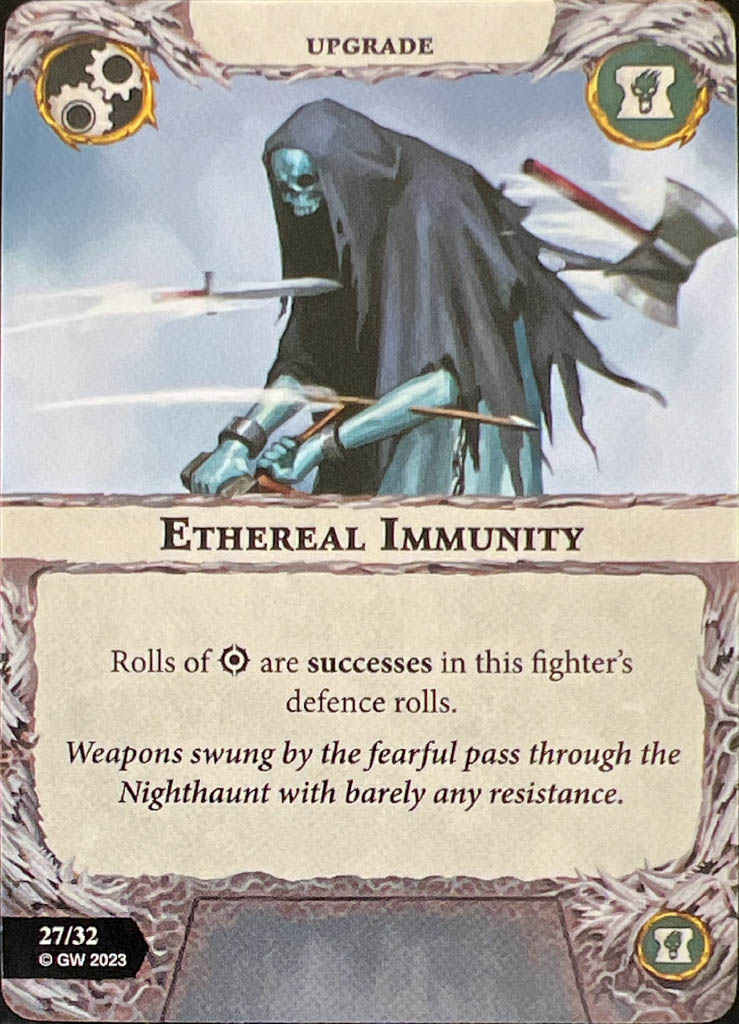

Ethereal Immunity allows you to count the double support symbol as a success in your defence rolls. This is fine as a little defensive boost, but it does clash with cover. Would’ve been much better if it default counted the single support symbol or counted as an additional supporting fighter. Neat tool though to support that [![]() Loyal Allies]
Loyal Allies] score.
score.
Power Ceiling: 2, Consistency: 2
Continuing the theme of very straightforward upgrade effects, Guided Blows grants you a re-roll on your attack actions. Most “big boy” type warbands tend to see their re-roll tech restricted (see [![]() Foul Temper]
Foul Temper]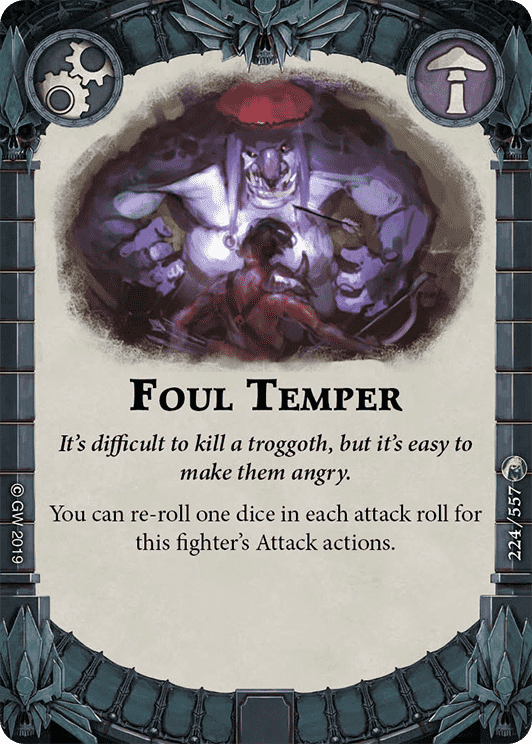 , [
, [![]() Hatred of the Living]
Hatred of the Living]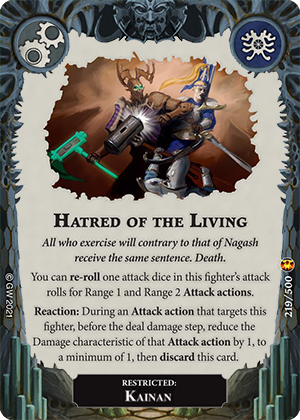 , [
, [![]() Famed Hunter]
Famed Hunter]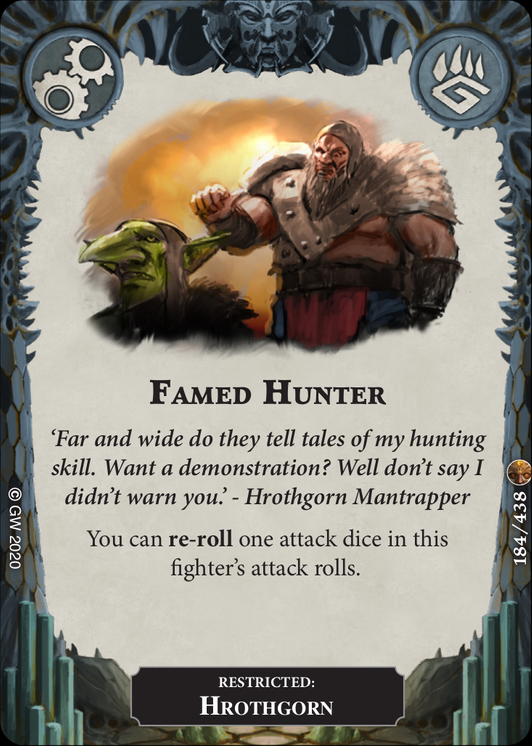 ) because they can do so much damage in one swing that adding any accuracy on top of those attacks is a big deal. Great card, always taking this one.
) because they can do so much damage in one swing that adding any accuracy on top of those attacks is a big deal. Great card, always taking this one.
Power Ceiling: 3, Consistency: 3
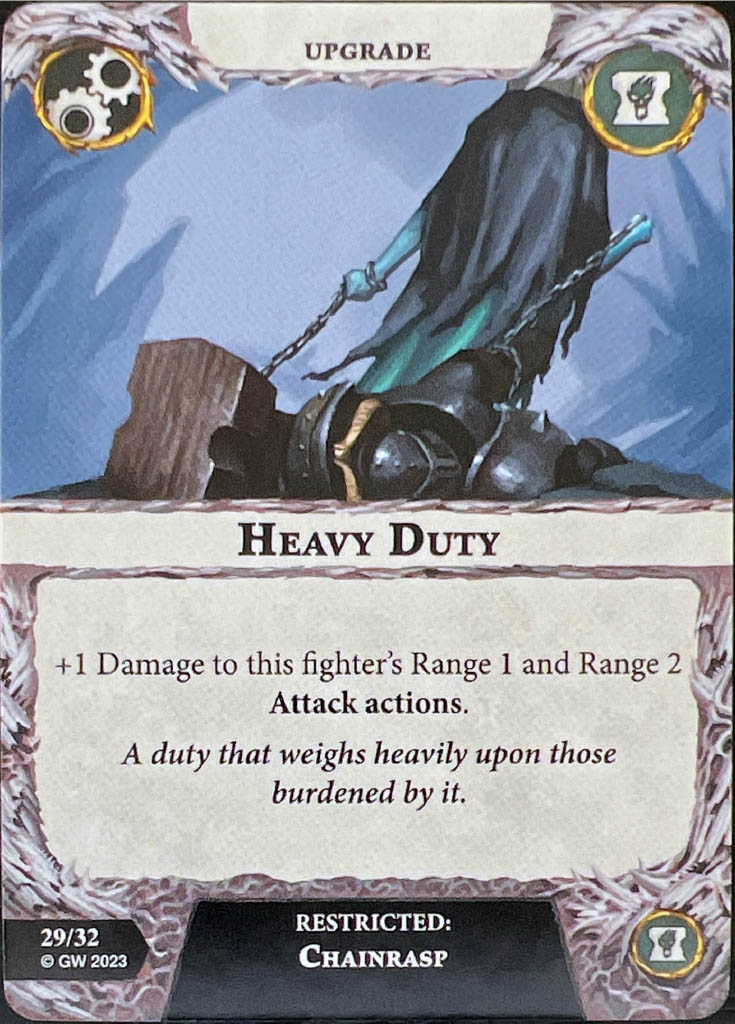
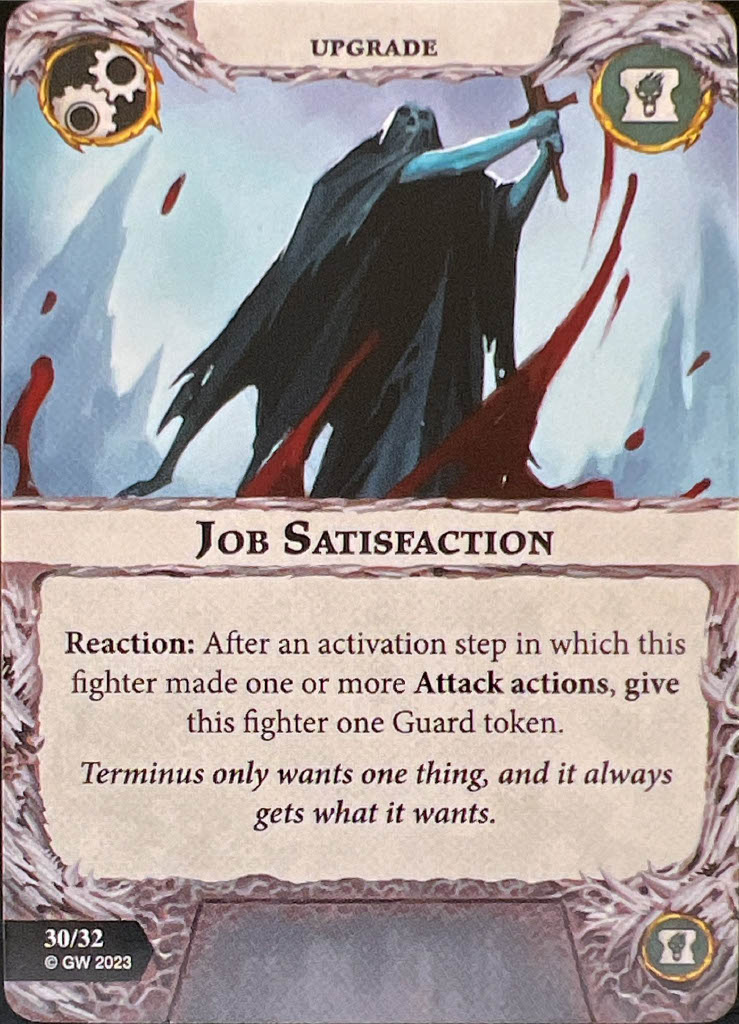
Heavy Duty is a great pun and also a [![]() Great Strength]
Great Strength]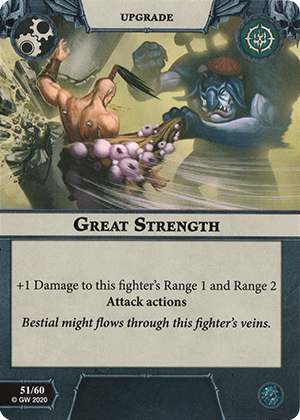 (but only for Chainrasps)! I know I said I’d like all my upgrades to work on the leader, but this is a strong enough effect that it is worth taking, I think. You might want a card like [
(but only for Chainrasps)! I know I said I’d like all my upgrades to work on the leader, but this is a strong enough effect that it is worth taking, I think. You might want a card like [![]() Cursed Boarding Pike]
Cursed Boarding Pike]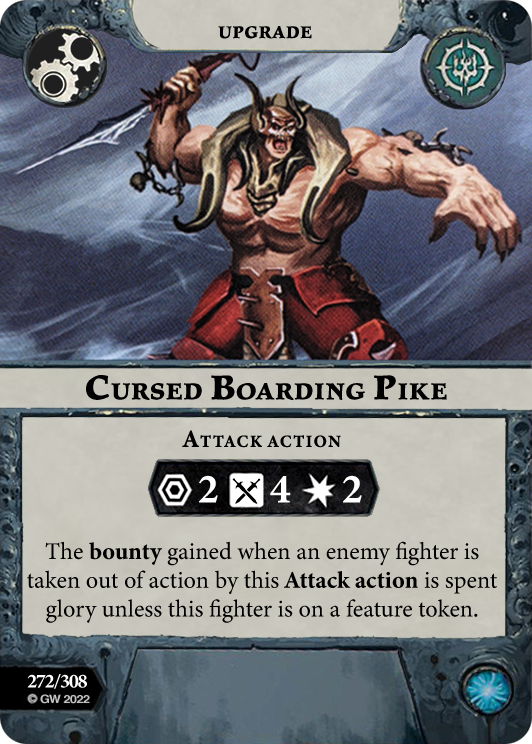 anyway just to give the warband some threat range, so that combos nicely and also makes it so that the Scriptor could use this card, if you were strapped for options. The name of the game is killing stuff, so it’s nice to potentially let your Chainrasps shoulder the load a bit. Just the inherent downside of still wanting Wielder to do most of the killing will push the value down a touch.
anyway just to give the warband some threat range, so that combos nicely and also makes it so that the Scriptor could use this card, if you were strapped for options. The name of the game is killing stuff, so it’s nice to potentially let your Chainrasps shoulder the load a bit. Just the inherent downside of still wanting Wielder to do most of the killing will push the value down a touch.
Power Ceiling: 3, Consistency: 2
Job Satisfaction is a more balanced take compared to what we’ve seen in past guard cards. Instead of always being on guard, this one just gives you a token after an activation in which you’ve made one or more attack actions with the equipped fighter. Not needing to land the attack to use the ability is pretty good. Being able to charge and mitigate the risk by going on guard is obviously really nice for a warband that is generally on 1 or 2 Dodge, but it’s also nice in the context of trying to set up support for your subsequent activations or holding down a particular feature token. It also means that, if you’ve been shedding fighters, you have a better shot at leveraging the new charge rule to potentially make multiple Range 1 swings. While guard is not that game-breaking in a world full of stagger effects, it’s a pretty sizeable defensive buff, especially in Rivals or Nemesis, where accuracy is harder to come by.
Power Ceiling: 2, Consistency: 3
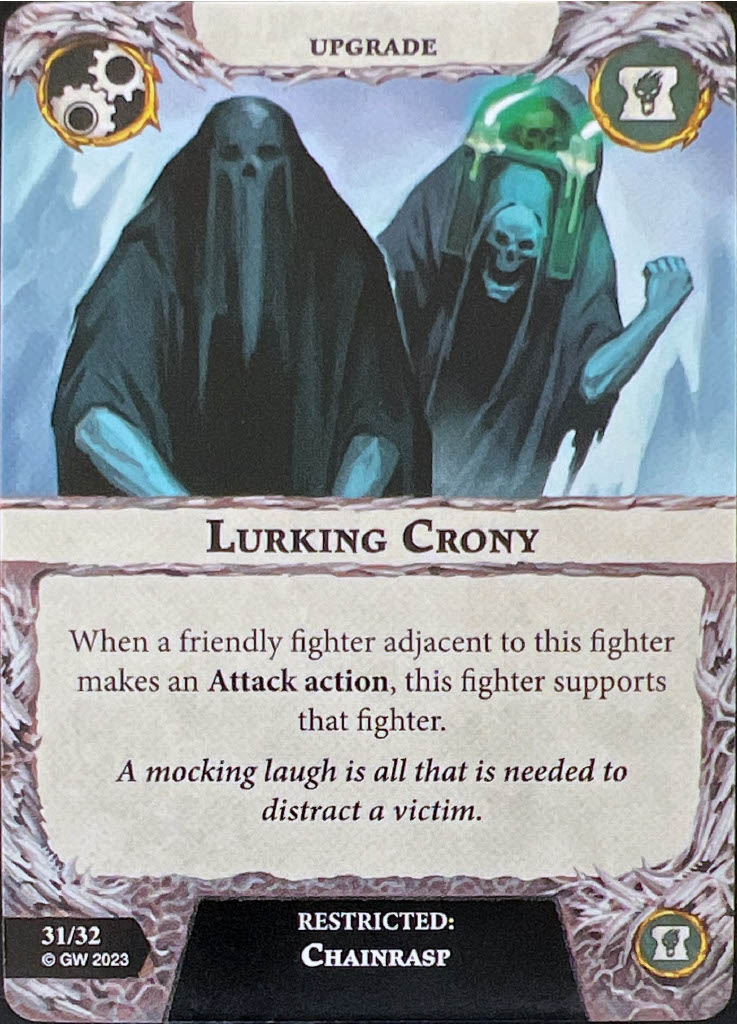
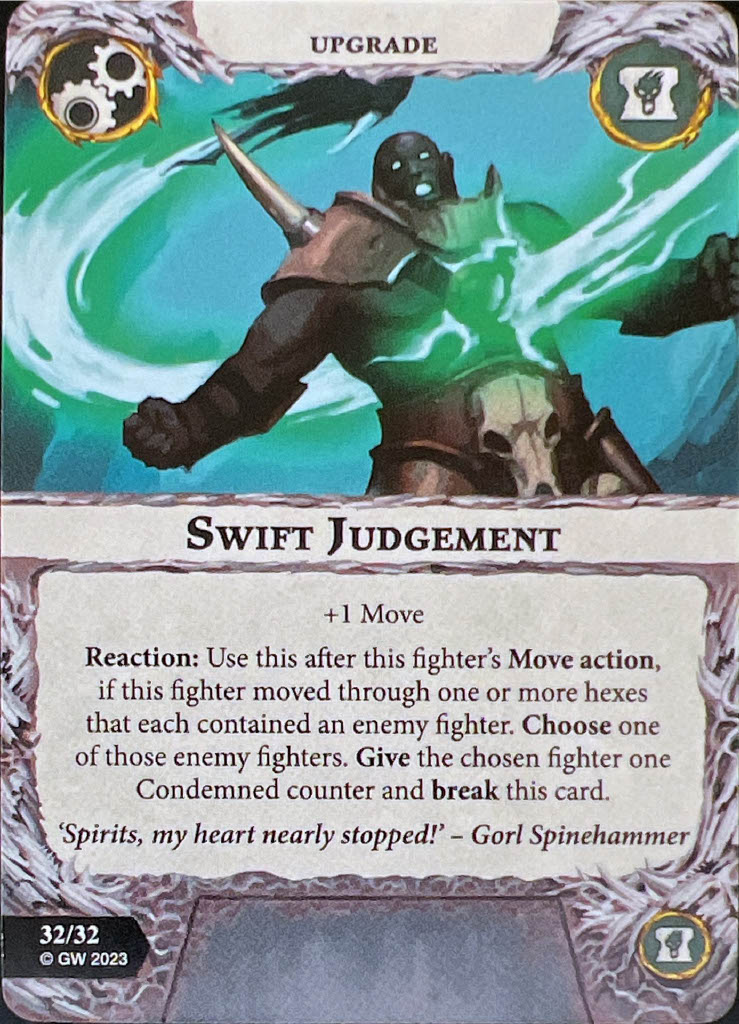
Lurking Crony is another Chainrasp upgrade, allowing the equipped fighter to support any friendly fighter it is adjacent to. Man would Profiteers love to have a card like this! However, given the general lack of range of the warband and other ways to get accuracy at Range 1, I think you probably end up leaving this more often than not. The most obvious synergy here is to put this on the Bearer to activate his cleave support more easily, although you generally want him actually adjacent to the target anyway to unlock the anti-guard tech. It’s fine, but a bit much in the positional aspect just to provide support, which you can already do with similar level of positional effort.
Power Ceiling: 1, Consistency: 2
Our final card in the set is Swift Judgement, which is another in a trend of +Move, +reaction upgrades that we’ve seen a lot of lately. This one grants you +1 Move and the ability to react by moving through an enemy fighter and giving them a condemned counter, then breaking the card. You could definitely use this on a charge to set up that potential extra condemned counter you need for an inspiration or objective score, but cards that effectively just give somebody a condemned counter are better off in your gambit selections than they are here. If it weren’t one-time use, I could see slapping it on the Wielder to make sure you are consistently racking up counters, but I just don’t think there’s enough upside here to warrant putting it in.
Power Ceiling: 1, Consistency: 2
Our Favorites
- Mark: Guided Blows
- Aman: Job Satisfaction
- Zach: Ethereal Immunity
Conclusion
Aesthetics aside, which I actually quite like, I do think the warband might be a bit flat mechanically. To preface this discussion, if you’ve read my other articles, I hope you’ll feel like I don’t complain just for the sake of it, but to provide actual constructive feedback as to what I personally feel would improve warband or card designs. In the case of the Headsmen’s Curse, I feel like the “theme,” such as it is, may be lacking when you compare to the chaos of Ephilim’s Pandaemonium or the shared power of Domitan’s Stormcoven. As I was reading through the deck, it often felt a bit more like reading through a smattering of universal cards, sometimes with the phrase “Condemned counter” added to them, rather than “wow, that’s a really interesting tech piece that’s unique to this warband.” As I harped on in the plot card section, I think a big opportunity was missed to create some internal synergy of the number of condemned counters you have with some of the faction cards. Cards could easily have been amended to have a base effect, then have a secondary effect if you have a certain number of counters. Just as an example, Deaf to Mercy could have been written in such a way to help you acquire counters faster if it said “This fighter’s attack actions have ensnare. This fighter’s attack actions also have cleave if their attack targets an enemy fighter with a condemned counter.” Of course, you could go in the other direction too and have cards with the option to discard condemned counters for additional effects or cards that scaled in power the more counters you had. Just providing some additional interaction with the counters you’re collecting I think would not only have made the warband more interesting to play, but also opened up the design space a bit more for the developers to create meaningful interactions. We know from past experience, with warbands like Reapers and Krushas, they are more than capable of executing these types of interactions in an interesting and engaging way.
I don’t mean to speak too harshly here and, to credit the developers, I think they did a good job setting this warband up to be decent without being overpowered (they seem to be about average to me in terms of power level), but they just don’t quite do it for me with regards to providing a fresh new way to play the game. With 50 warbands or whatever we have in the game, maybe it is unfair of me to expect something so distinct each time we get a new warband, but I think that is another credit to the developers. Their designs have been so good that I now expect to have this sort of experience every time a new warband is released. If you love the warband and think I’m totally off base here, great! I’m sure that plenty of people will fall in love with them and, by all means, I hope you enjoy the heck out of them. The great thing about Underworlds in general is that there is usually something to suit everyone’s tastes and not everyone is going to like the same stuff. In fact, the game tends to be at its worst when everyone is playing the same couple of warbands, so it’s not like some added diversity is ever a bad thing.
With my tangent now complete, thanks so much for reading to this point and, of course, best of luck on YOUR Path to Glory!


